“A young man following a mere ‘spotted path’ from the south into the untamed wilderness.”
*
Collectively referred to now as West Hartland, this broad region includes the original settlement location of what was then known as Township No. 3 in the 1st Range north of the Plymouth Claim. Before and after its incorporation as the Town of Hartland in 1820, early town politics and other town affairs were primarily conducted in West Hartland for a few decades before the Village eventually replaced it as the center of town business. In its early years of settlement, West Hartland was comprised of several populated areas including among others, Fullers Corner, Morrill Pond, Chase Hill, Slab City, Bean’s Corner and Huff Hill where clusters of various families began to settle together soon after James Fuller, Sr arrived in the area in 1802. These early settlers were predominately farmers but eventually there were numerous small businesses in these populated areas including sawmills, shingle mills, blacksmiths, brickyards and stores. Many of these early areas in West Hartland often had their own schoolhouse, common places of worship and cemeteries.
*
Currently, no maps of Hartland detailing the locations of homes, businesses and merchants before 1860 have been discovered. Various documents provide us with enough information to know many existed in its early years of settlement, but most of the specific details of when they were built or by whom remain unknown. The following is based on our best interpretation of known maps, town records, census data, historical book references, photos, artifacts and family genealogical information. Updates will be made as new information is discovered.
*
It is in West Hartland where we bear witness to the humble beginnings of a town when in 1802 a young man from New Hampshire named James Fuller followed a mere “spotted path” from the south in search of the plot of land in then Township No. 3 he had purchased from Dr. John Warren. Fuller staked his claim at what became known as Fullers Corner and began the task of building lodging despite the seemingly impossible odds against survival in what was nothing but untamed wilderness at the time. One wonders, as he felled the first of many trees to build his home, could he have ever expected some two centuries later his descendants would still be living in the town he was the first to call home.
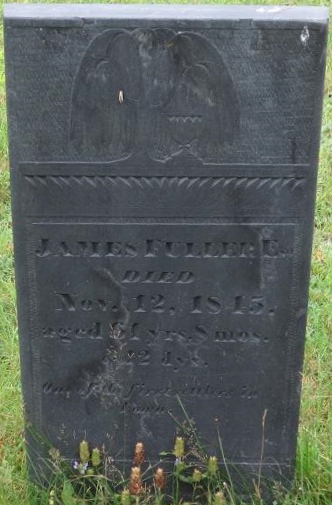
James Fuller, Sr (1784-1845) – Fullers Corner Cemetery
*
When Dr. John Warren purchased Township No. 3 in 1799, the future town of Hartland was a 30,000 square acre lot which had been surveyed as a uniform rectangular lot. This uniform method was common practice for surveyors laying out the numerous new northern Maine “wilderness” townships which had just recently become available for Land Proprietors to sell and settle following the end of the Revolutionary War. Albeit convenient for the latter parties, it typically ignored the area’s natural boundaries and often made for unrealistic future access to education, town affairs and services for settlers who came to live there. Hartland was no exception and each of its original surveyed town lines were eventually changed to follow closer to its natural boundaries to meet the needs of its new inhabitants.
Original borders of Hartland as surveyed by Samuel Weston in 1791 and as deeded to Dr. John Warren in 1799.
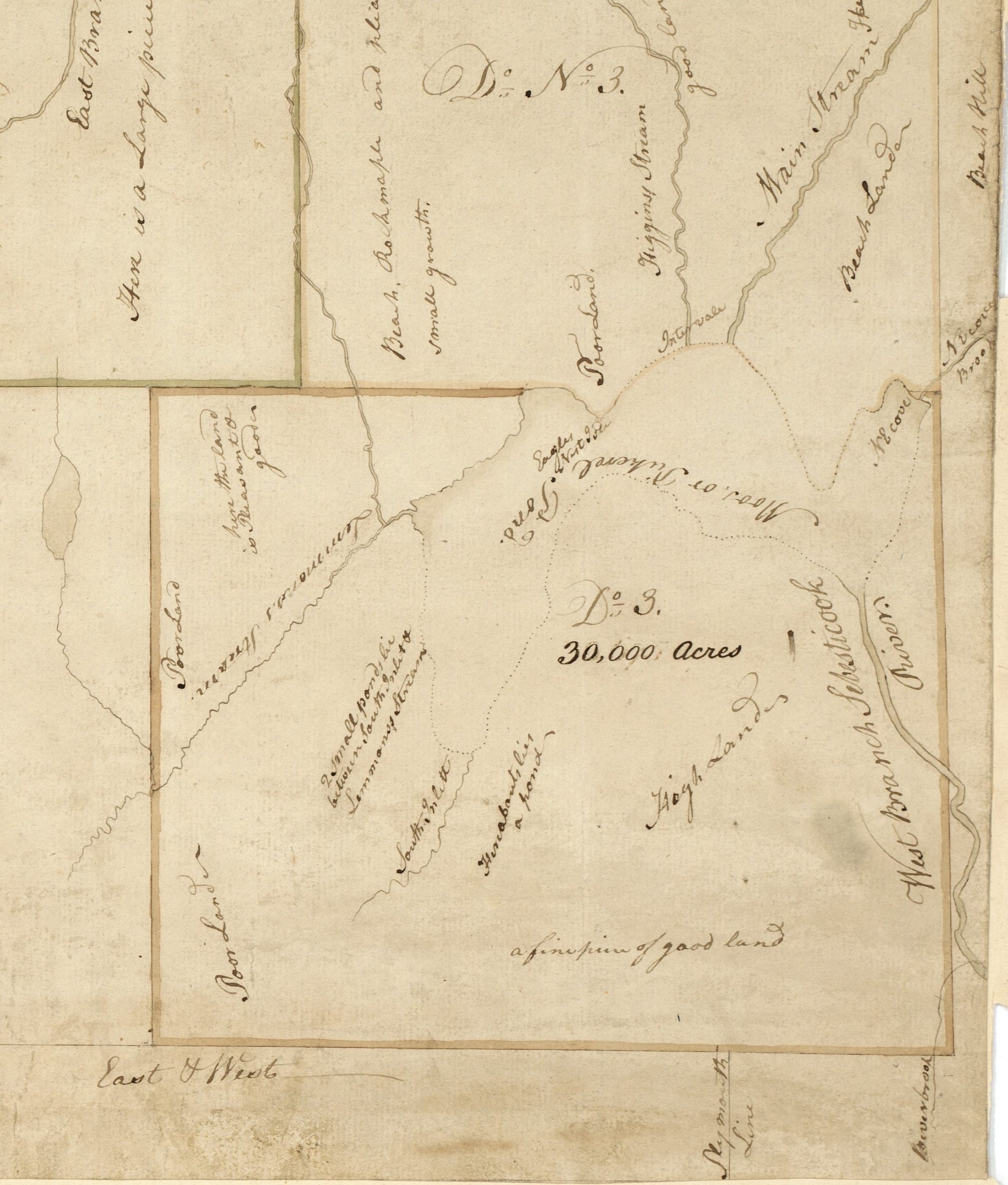
1791 Samuel Weston Survey of Township No. 3 in the 1st Range north of the Plymouth Claim
*
What was NOT included in the original 1791 survey or the 1799 deeded borders was a section of unclaimed land below Hartland’s southern border which was part of the so called “Gore of a Mile and a Half Strip”. Settlement in this section of the Strip below Hartland had begun not long after James Fuller Sr settled at Fullers Corner and by the time the petition to incorporate as a town was raised in 1819, it had been claimed by Hartland as part of its borders as included from the petition in part as, “South by the L of Palmyra and the Mile and a Half Strip, so called”.
*
The entire original Mile and a Half Strip is highlighted below from a 1795 Map of the area with Hartland noted as Township No. 3.
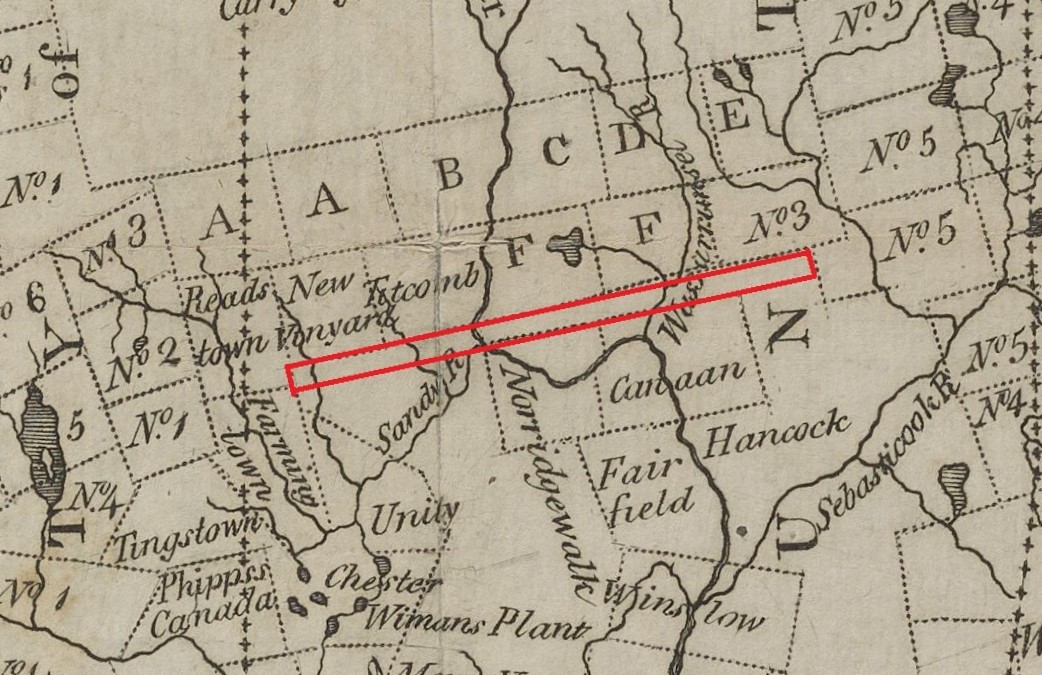
The Mile and a Half Strip – 1795
*
It was not uncommon for cartographers to use combinations of survey maps or deeds as part of their resources to indicate map border lines. However, sometimes these sources were outdated and unintentional errors were made on the final rendering. We may presume this the case when Hartland’s southern border was erroneously drawn on Moses Greenleaf’s 1820 Map of Maine with its originally surveyed and deeded border without the documented addition of the Mile and a Half Strip.
*
This edited version of the original 1820 Greenleaf Map includes the approximate location of the additional Mile and a Half Strip southern border.
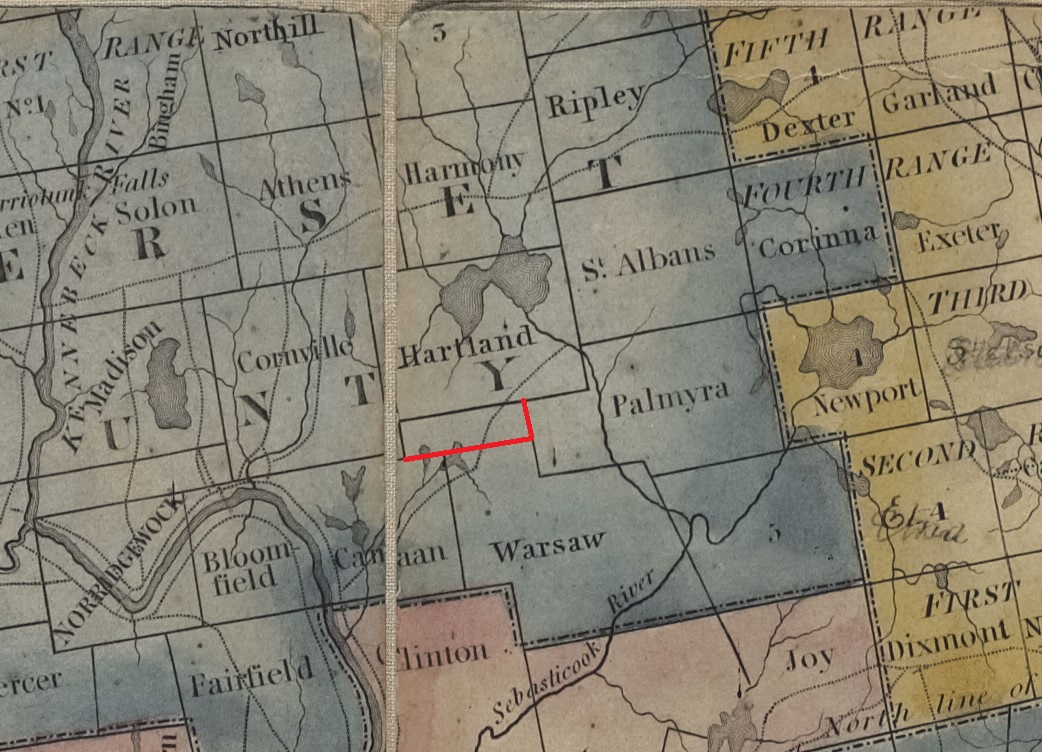
(Edited) Hartland Southern Border with Mile and a Half Strip from Greenleaf’s 1820 Map of Maine
*
Several of the early West Hartland Families were noted in the 1911-1912 East Somerset County Registry and are presented below as written with edits and a link to further details on their respective family lineage, when available, on our Family Tree Page.
*
James Fuller, Sr (1784-1845) was the first permanent settler of the future town of Hartland. Fuller came from Exeter, New Hampshire in 1802 and was prominent in the early affairs of the settlement. The region was an utter wilderness with very few inhabitants for many miles and it is even related that while he was clearing his land he was obliged to go for nearly ten miles to get his ax ground. Mr. Fuller’s first wife was Rebecca Lancey of Palmyra (1793-1829) and to them were born the following children; (John) Warren Fuller, Thomas Fuller, James Fuller Jr, Elizabeth Fuller (m. Hiram Burrill) & George Fuller. Following Rebecca’s death, James remarried to Elizabeth Lancey, a younger sister of his first wife. Their children were; George L. Fuller, Samuel Fuller, Josiah Fuller, Edward Fuller & Rebecca Fuller (m. John Larrabee). He signed the petition for Hartland’s incorporation as a town in 1819.
Peleg Thompson (1789-1869) moved into the town during the early days of its development and settled and cleared the farm now (in 1912) occupied by his grandson, Fred Thompson. He built a log house at first, as did most of the first comers to the town, and later replaced it with a frame structure. Mr. Thompson cleared much of the farm and his son Prince Thompson completed the clearing and built the large two story house which now occupies the farm. Mr. Thompson brought up a family of seven children.
Ambrose Finson (1789-1857) came to West Hartland from Pejepscot (Danville) about 1809. He cleared the farm now (1912) occupied by John Goodwin and built a log house. He signed the petition for Hartland’s incorporation as a town in 1819. Mr. Finson’s house served as a Town Hall in the early days of the town and the people assembled here for their Town Meetings. The fields cleared by Mr. Finson were used as a training field for the muster. He served in the capacity of Justice of the Peace and County Commissioner and was sent three times to the Maine Legislature. Mr. Finson, or Squire Finson as he was called, was held in the highest esteem by his fellow townsmen, being often called upon to settle disputes between his townsmen. It is said that his decisions were never questioned. He and his wife Elizabeth Jordan had a family of seven boys and three girls; Ambrose Finson Jr, Thomas Finson, James Finson, John Finson, Henry Finson, Amasa Finson, Greenleaf Finson, Elizabeth Finson (m. Greenleaf Church), Emeline Finson (m. Darius Rand) & Mary Finson (m. John Butterfield, Jr).
William Larrabee (1796-1850) and his wife Sarah Plummer came from Pejepscot (Danville) and cleared the farm now owned by Mr. (Moses) Ames in West Hartland. Mr. Larrabee was one of the early town officials, serving several times as Selectman. To them were born ten children, eight of whom lived to reach mature years; William Larrabee, Jacob Larrabee, Jane Larrabee, Hugh Larrabee, Andrew Larrabee, John Larrabee (m. Rebecca Fuller), George Larrabee & Stephen Larrabee.
Nathaniel Woodbury, Sr (1752-1850) came from New Gloucester to Hartland by 1810 with his wife Anna Nevens and settled on Huff Hill with several of their younger children. Their children were; Charles Woodbury, Charlotte Woodbury (m. Hurd), Samuel Woodbury, Isaiah Woodbury I, Nancy Woodbury (m. Moses Huff), Israel Woodbury, Nathaniel Woodbury, Jr, Moses Woodbury & Sarah Woodbury (m. James Jordan).
Isaiah Woodbury I (1784-1878), son of Nathaniel Woodbury, Sr came from New Gloucester to Hartland with his wife Thankful Libby soon after his parents and settled in West Hartland where he put up a log cabin and settled on the place where Wallace Goodwin now (1912) lives. He is said to have been the first to begin work in clearing the land on the hill. He signed the petition for Hartland’s incorporation as a town in 1819.
Israel Woodbury, Sr (1790-c1880), son of Nathaniel Woodbury, Sr and Veteran of the War of 1812, came to Hartland about 100 years ago (1812) soon after his parents and cleared a farm on Huff Hill. He married Abigail Spencer and to them were born the following children; Esther Woodbury (m. Charles Magoon), Druzilla Woodbury, Isreal Woodbury Jr, Louisa Woodbury (m. Maurice Lincoln), Mary Woodbury (m. Beede), Charles Woodbury & Abram Woodbury.
Hobbs Perkins (1777-1859) came from Wells and was an early settler on Huff Hill where he and his wife Lois Spencer built a log house and with the help of his sons cleared a farm on what is now (1912) the Town Poor Farm. Their sons were Jotham Perkins, Spencer Perkins & Erastus Perkins. Their daughters were Anne Perkins (m1. Demons, m2. Rowell), Casandana Perkins (m1. Joseph Berry, m2. Obed Dore), Maria Perkins (m. Coffee), Beulah Perkins (m. Decker) & Ruth Perkins (m1. Allan Berry, m2. Jesse Merrill). He signed the petition for Hartland’s incorporation as a town in 1819.
John Spearin (1764-1830), a Revolutionary War Veteran, was born in Pownalbourough (Wiscassett). He and his wife Mary Kendall moved to Clinton by 1790 and to West Hartland by 1810. He signed the petition for Hartland’s incorporation as a town in 1819.
Joseph Bowley (1772-1843) settled in West Hartland by 1810 and married Lydia Spearin, daughter of John Spearin. He signed the petition for Hartland’s incorporation as a town in 1819.
John Whiting III (1759-1846), a Revolutionary War Veteran, came from Lovell and married Margaret Fairbrother, daughter of Lovell Fairbrother, in 1806 and was living in West Hartland at the time of the 1810 Census. “Lovell Fairbrother came to the Kennebec at an early day and explored this river and the Sebasticook River; found choice intervale at or near the fork of that river, and abundance of fish in the river and game in the forest. He therefore pitched his tent at a big camp near the forks of the river in 1775 and moved his family there being joined by two others and this commenced the settlement in what is now the prosperous town of Pittsfield, then called Sebasticook Plantation.”
*
Some of the other known early settlers in West Hartland not noted in the 1912 Register include:
(Additions pending)
*
Thomas Huff III (1733-1841), a Revolutionary War Veteran, moved from Arundel (Kennebunkport) by 1810 to what would become known as Huff Hill with his wife, Mary Bridges, and 3 of their sons, Benjamin, James & Moses Huff who would marry Nancy Woodbury. Future accounts of the family claim Thomas lived to be 108 years old.
Solomon Spencer (c1752-1838), a Revolutionary War Veteran, was living in Canaan in 1810 before moving to West Hartland where he applied for his war pension in 1818. His daughter Lois Spencer married Hobbs Perkins. Solomon signed the petition for Hartland’s incorporation as a town in 1819 and was listed there in the 1820 Census.
Ezekiel Dunlap (1797-c1872), a War of 1812 Veteran, was living in West Hartland by 1810. He married Susan Phelps in 1815 and they were living in West Hartland in 1820 with their children. He signed the petition for Hartland’s incorporation as a town in 1819. They moved to West Pittsfield by 1830 then onto Skowhegan by 1850 where the remained until their deaths soon after 1870.
Andrew Phelps (1774-????), was living in West Hartland near Huff Hill by 1810 with his wife Susanna and their 10 children. He signed the petition for Hartland’s incorporation as a town in 1819. Their daughter Susan Phelps married Ezekiel Dunlap.
John Nevens (1780-1850) settled on Herrin Hill then within the town limits of Hartland. He came from Pejepscot (Danville) when this part of the country was an unbroken wilderness, traveling part of the way from Danville by means of a spotted line through the woods. His wife was Mary Ray and four more children were born to them in Hartland; Charles Nevens (m. Roxana Wheeler), David Nevens (m. Susan Finson), John Nevens Jr (m. Nancy Washburn) & Julia Nevens (m. William Rines).
James Morrill (1788-1856), a War of 1812 Veteran, moved from Gray by 1820 to West Hartland along the shores of the body of water that now bear his namesake as Morrill Pond. James and his wife Olive Hayden raised a large family of 11 known children. He was active in town affairs serving as an early Constable and other offices. James and Olive are interred at Fullers Corner Cemetery along with his widowed mother Elizabeth (Jewell) Morrill who came to Hartland with them.
Henry Herrin (1791-1873) settled in West Hartland where he took an active role in early town affairs serving as Town Selectman and Town Clerk before his homestead became part of Canaan in 1849. He and his wife Rachel Starbird are interred at Slab City Cemetery in Canaan.
Benjamin Chase, Sr (1791-1874), a War of 1812 Veteran, first settled in Canaan before he and his wife Lucy Burrill moved to West Hartland in 1827 to the area which would eventually bear his namesake, Chase Hill. Benjamin & Lucy are interred at Brown’s Corner Cemetery in Canaan.
Samuel Jewett (1776-1857) and his wife Betsey Steward (1787-1849) came from Norridgewock to West Hartland by 1810 where they were listed in the 1810 Census for then Township No. 3. He signed the petition for Hartland’s incorporation as a town in 1819. Their homestead became part of Canaan in 1849. His father Maximillian Jewett served in the Revolutionary War and moved to Bloomfield (Skowhegan) with his family after the war. Samuel’s interment is unknown but Betsey is interred at Slab City Cemetery in Canaan. Their oldest of 10 children, Eliza Jewett, married David Mitchell.
David Mitchell (1798-1873) came from Durham to West Hartland about 1818 together with settlers by the name of Nevens, Vincent and Jordan and signed the petition for Hartland’s incorporation as a town in 1819. He made his settlement just north of Morrill Pond near Herrin Hill where he was listed as the only person in his household in the 1820 Census for Hartland. Soon after the Census was taken, he married Eliza Jewett (1804-1874) and they raised a large family of 10 children. In 1865, David & Eliza moved to Canaan where they had bought a 40 acre farm from Scammon Burrill who moved to North Hartland.
Richard Hopkins (1812-1892) came with his family from England to Manchester, Maine before he moved to West Hartland by 1840 with his wife Rachel Pinkham of Litchfield. They lived on a farm which was only slightly cleared near the eventual southwest border of West Hartland and Canaan formed in 1849. They had four children; William Hopkins, Thomas Hopkins, Sarah Hopkins and Martha Hopkins who married FiField Mitchell, son of David Mitchell.
John Wentworth Jordan (1790-1861) & Foster Jordan (1807-????) were brothers of Elizabeth (Jordan) Finson. John married Elizabeth McKenney and Foster married her sister Rebecca McKenney and both couples settled in West Hartland near their sister’s home.
Amos Tucker, Sr (1780-after 1870), moved from Pejepscot to West Hartland soon after 1810 where he and his wife Sarah Nevens and their 2 young daughters settled on the future Morrill Pond Road just west of Fullers Corner where 6 more children would be born to them. He signed the petition for Hartland’s incorporation as a town in 1819.
Jonas Wheeler (1791-1866), a War of 1812 Veteran, was living in Canaan when he and his brother Joseph Wheeler enlisted as Musicians for the war in 1814. Following his marriage to Eunice Brown in 1815, they resided in Canaan before moving to West Hartland after 1820 where they remained until their deaths. 7 children were born to them; William, Ira, Lowell, Wesley, Elizabeth (m. Francis Mitchell; son of David Mitchell), Simon & Nathan Wheeler. Jonas & Eunice are interred together at Nevens Cemetery.
*
Two Public Cemeteries are located in West Hartland where many of the early settlers are interred. Click below for details:
Fullers Corner Cemetery
Nevens Cemetery
*
James Fuller, Sr originally farmed his newly purchased land but he had also settled adjacent to the “County Road” which became a major Stage Coach route from Norridgewock to Bangor. Fuller seized the business opportunity and built a Stage Coach Stop & Tavern to service the well traveled route which originated some 35 miles to the west in Norridgewock which was the county seat at the time. Fuller’s Tavern, which also served as one of several locations for early Hartland Town Meetings, had the reputation for a long time of being one of the few prohibition era “public houses” in Maine.
The Norridgewock to Bangor Stage Coach Route via the County Road entered West Hartland from Canaan running past Fuller’s Tavern and across Pittsfield Avenue at Davis Corner into Palmyra. It crossed over the Sebasticook River Bridge onto the Gale Road into Palmyra Village then onto Newport, Stetson and its final destination in Bangor.
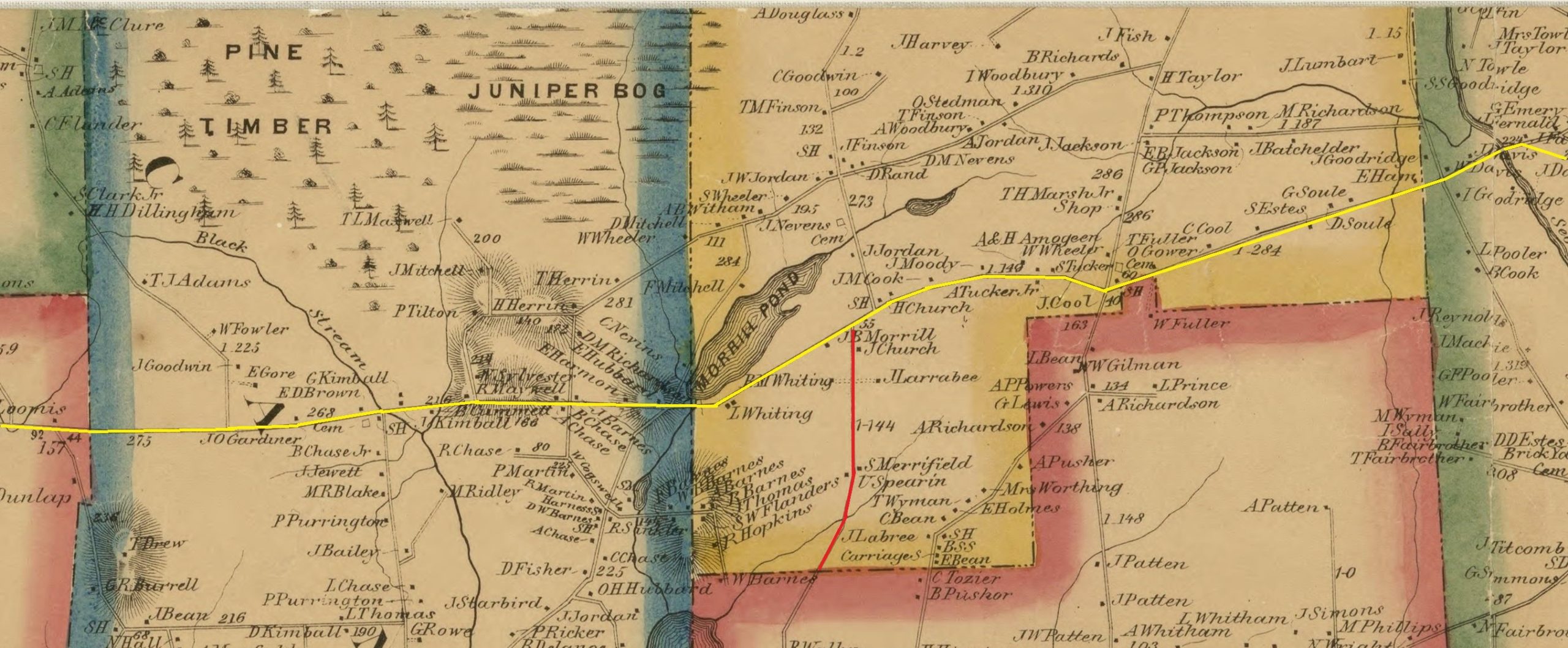
Norridgewock to Bangor Stage Coach Route via County Road
(Courtesy of Donald McDougal)
*
In its early years as a township and then an official town, most of Hartland’s town business affairs were conducted in West Hartland which served as the primary location for Town Meetings up until the early 1840s. Town Meetings, which were then held twice a year in March and November, were held at several West Hartland locations some of which were located in the portion later ceded to Canaan. Among the meeting places were the homes of Joseph Steward, Henry Herrin and Ambrose Finson as well as Church’s Corner Schoolhouse and James Fuller’s Tavern.
As the population of North Hartland grew and the Village’s boundaries were expanded between Hartland & St Albans in 1846, a slow but steady shift of the center of town affairs to the Village began to develop. In 1843, one of the bi-annual town meetings locations was changed for the first time to the Ireland Schoolhouse on Pleasant Street likely as a compromise to accommodate the population changes.
*
On July 17, 1849 a large portion of the original southwest corner of West Hartland was annexed to Canaan.
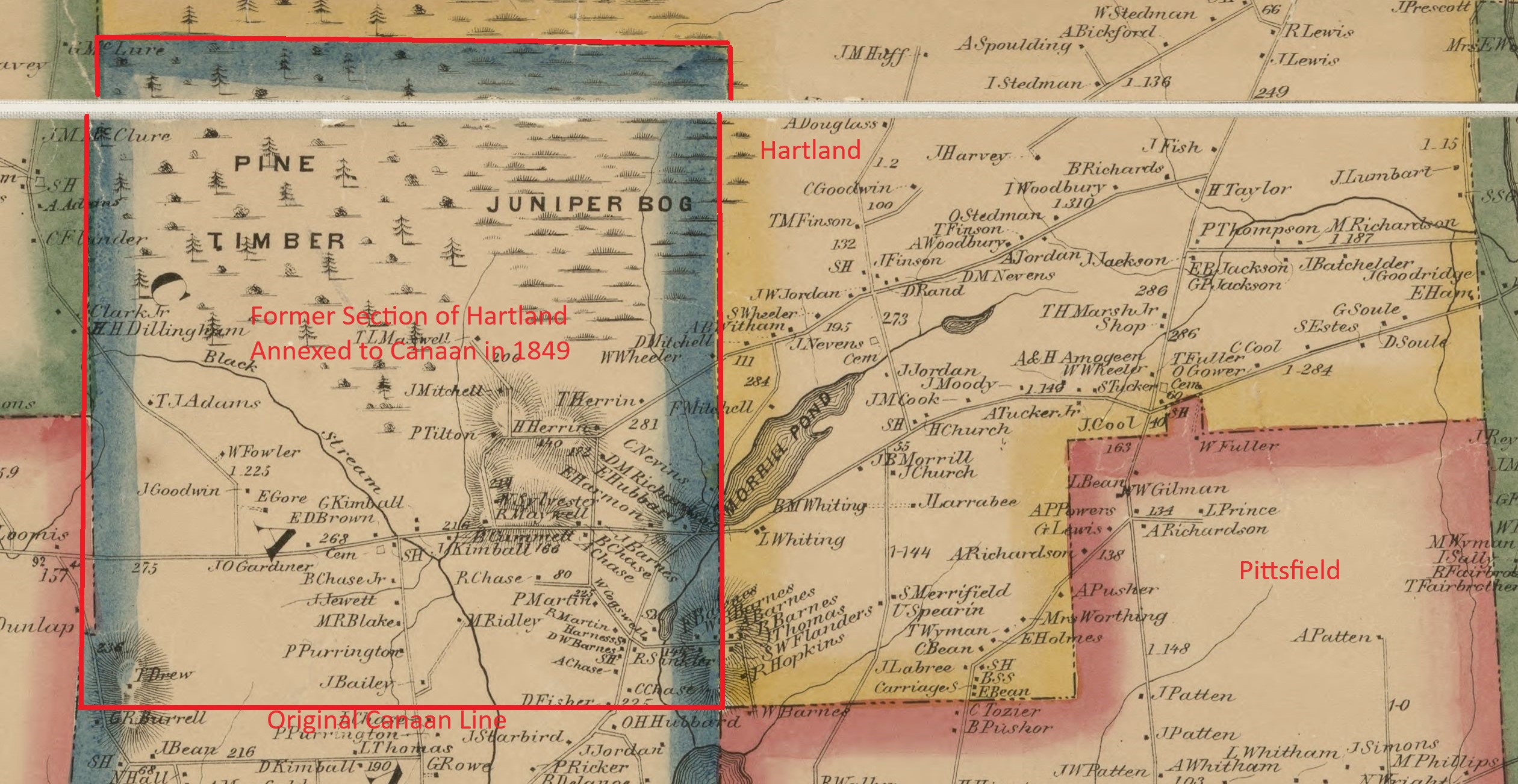
Section of Hartland Annexed to Canaan from 1860 Somerset County Map
For a complete and enlargeable version of this original map, click the link below:
1860 Map at Library of Congress
*
In 1852, John Warren Fuller (1814-1887), known as Warren Fuller, petitioned the Maine Legislature to annex his 15 acre property in West Hartland to Pittsfield. Fuller, the eldest son of James Fuller Sr, had been an active member in town affairs having served as Town Constable and at the time of his petition was Representative to the Maine Legislature. Local legend holds there was some kind of dispute between Fuller and Hartland town officials concerning the handling of certain affairs. Regardless of what actually happened to prompt his rather defiant action, Fuller’s petition was successfully enacted on March 11, 1852 and his entire homestead became part of Pittsfield. Warren and his wife, Esther Butterfield, are interred at Fullers Corner Cemetery.
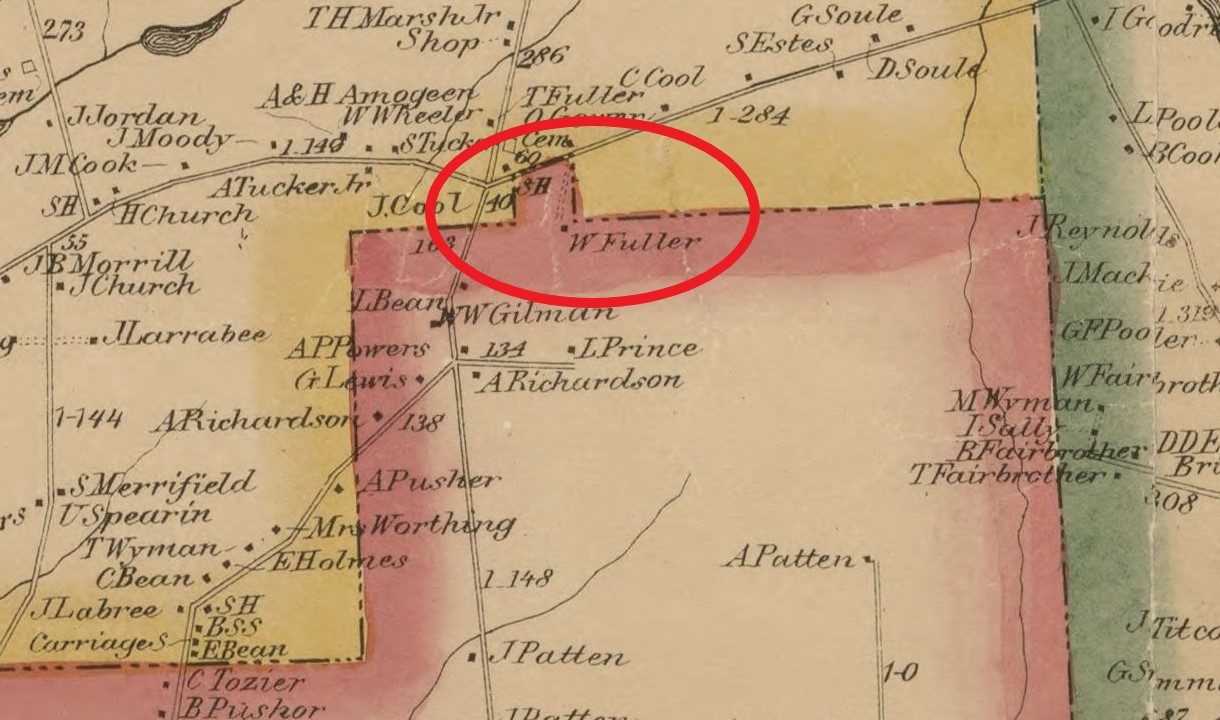
Warren Fuller Lot – 1860
*
Following Warren and his wife Esther’s deaths, all the buildings on their land eventually fell into disarray and the lot remained uninhabited for decades. In 1969, Pittsfield attempted to gift the lot back to Hartland after a family had set up residence on part of the lot requiring their school bus to travel an extra 8 miles a day to accommodate one of the school age children.
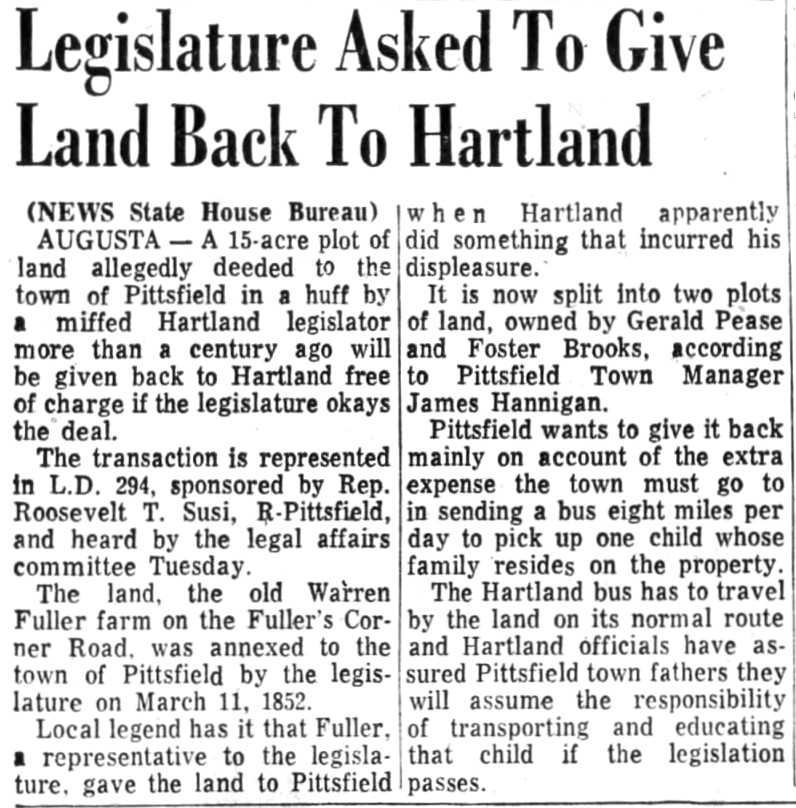
Bangor Daily News – February 12, 1969
*
Although the proposal (LD294) was brought before the Legislature on February 11, 1969, Hartland had already hinted beforehand it would likely not accept the proposal. As noted by their House Representative Frank Quimby, “The citizens of Hartland do not feel they should have to accept this gift against their wishes, and the Town Manager of Hartland (Edgar Woodman) has said they don’t feel they want to accept the gift as is.” Hartland voters officially declined the offer during their Town Meeting in March and while it remained in Legislation, further action on the proposal was formally postponed indefinitely on April 4, 1969.
*
Confusion at the time concerning the lot’s future prompted a light hearted gesture by the Pease Family as they awaited a decision on their property.
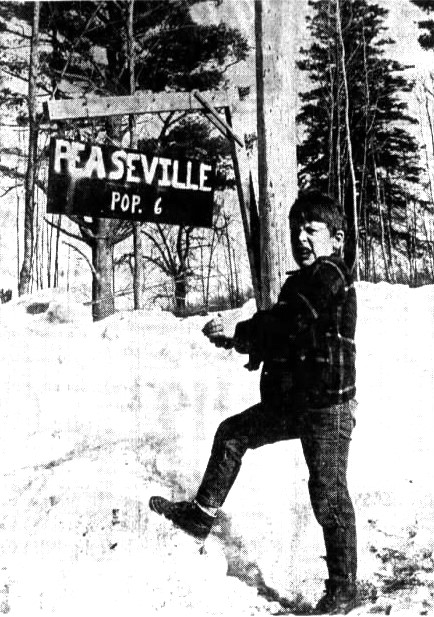
Portland Press Herald – March 30, 1969
*
It would be 145 years before the 118th Maine Legislature formally reversed Warren Fuller’s property secession from Hartland when it passed LD71; An Act to Return a Certain Parcel of Land to Hartland from Pittsfield, effective on March 28, 1997 and enacted as follows:
- Section 1. Private & Special Law, Chapter 509, March 11, 1852 is repealed.
- Section 2. That parcel of land in the Town of Pittsfield that was annexed to Pittsfield pursuant to Private and Special Law, Chapter 509, March 11, 1852, is annexed to and made a part of the Town of Hartland.
*
The first documentation of Hartland Common Schools comes from 1820 when 6 School Districts were established throughout the newly incorporated town in the major population settlement regions including the West Hartland Districts. As town line boundaries and populations shifted over the decades, up to a dozen districts existed in Hartland.
*
7 of the known Schoolhouses located in West Hartland include:
- Fullers Corner School: Last of all the rural schools to close in 1942
- Slab City School: Southwest of Morrill Pond, later became part of Canaan Schools
- Church’s Corner School: South of Morrill Pond, closed by 1900
- Palmyra School: Unknown school name, located near Pittsfield Avenue, closed by 1900
- Rand School: North of Morrill Pond, closed 1917
- Huff Hill School: Closed 1917
- Bean’s Corner School: Later became part of Pittsfield Schools, closed 1931
*
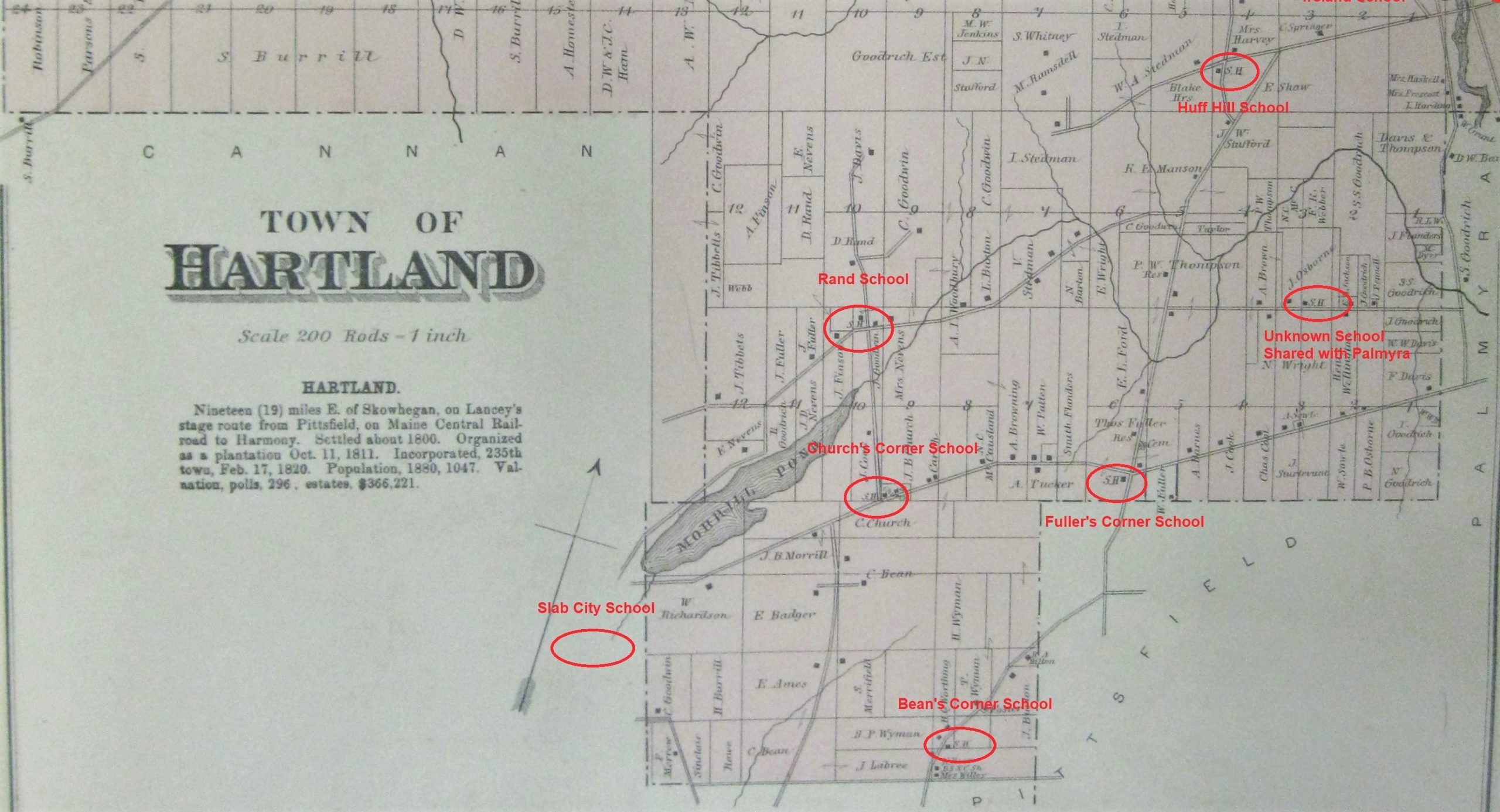
West Hartland Schoolhouse Locations – 1883
*
Fullers Corner School Brochure
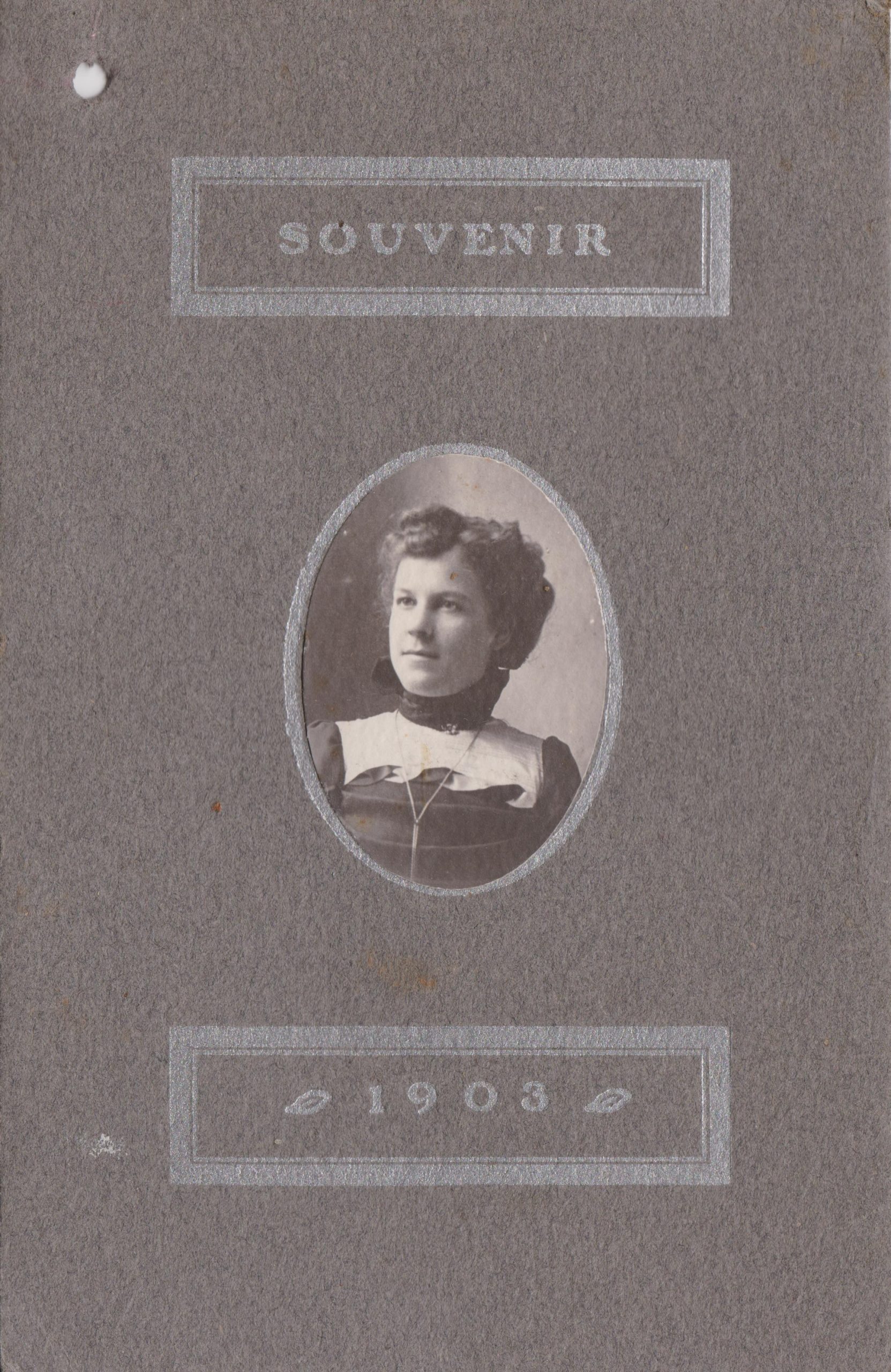
Teacher Miss Laura Effie Randlett (daughter of Harrison Randlett & Ellen Fuller)
*
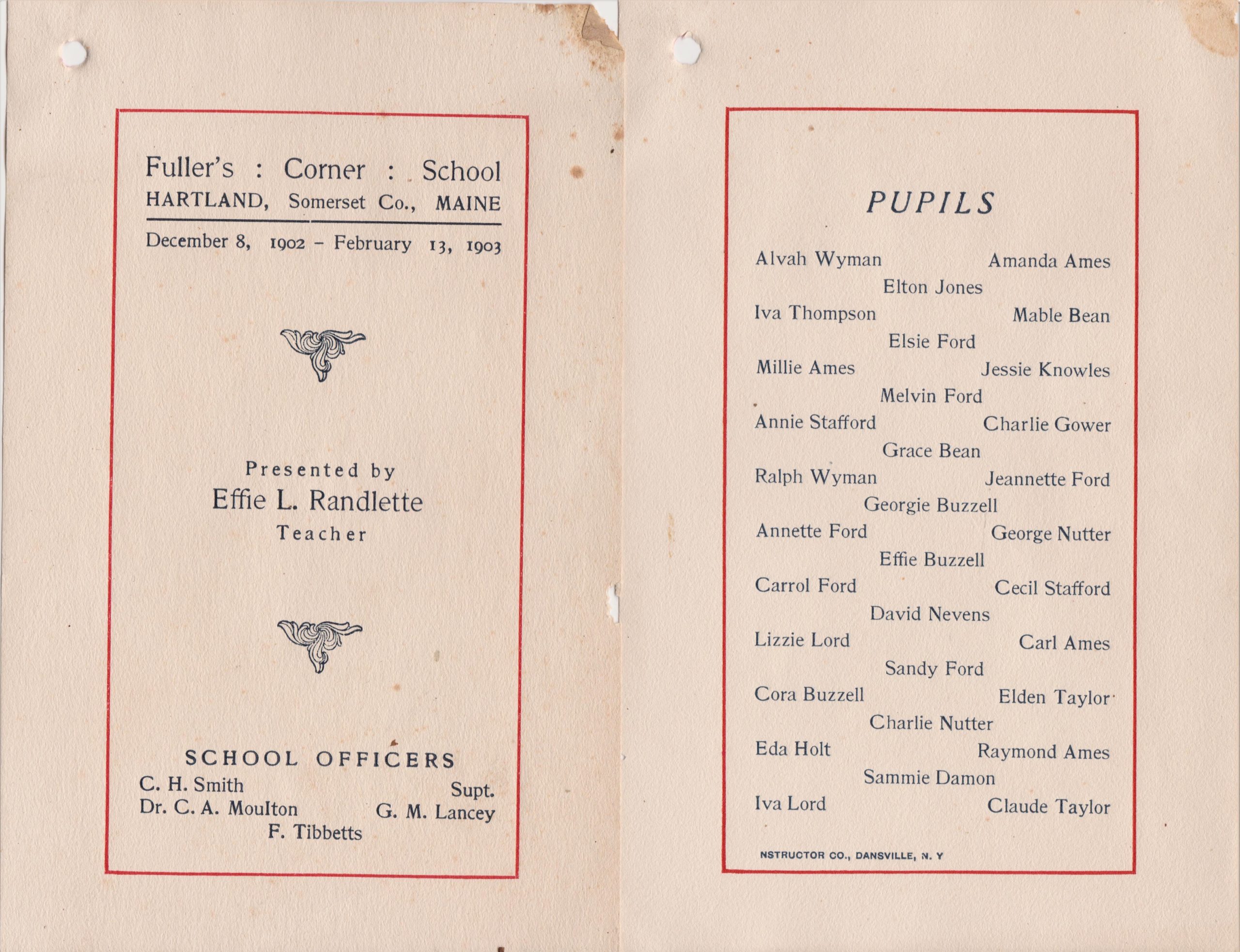
Fullers Corner School Brochure 1902-1903
(Courtesy of Virginia Salibury Tucker)
*
In 1866, Hartland opened its first dedicated Town Farm on Huff Hill in West Hartland. Town Farms, also called Poor Farms or Almshouses, were usually the last resort for the poor, the elderly and physically or mentally challenged people who were unable to financially support or take care of themselves.
By 1920, the Town Farm was closed and the buildings and land were eventually purchased by Carl Randlett before Earl Sherburne purchased the homestead in 1943 living there with his family until the farmhouse burnt down in the early 1960s.
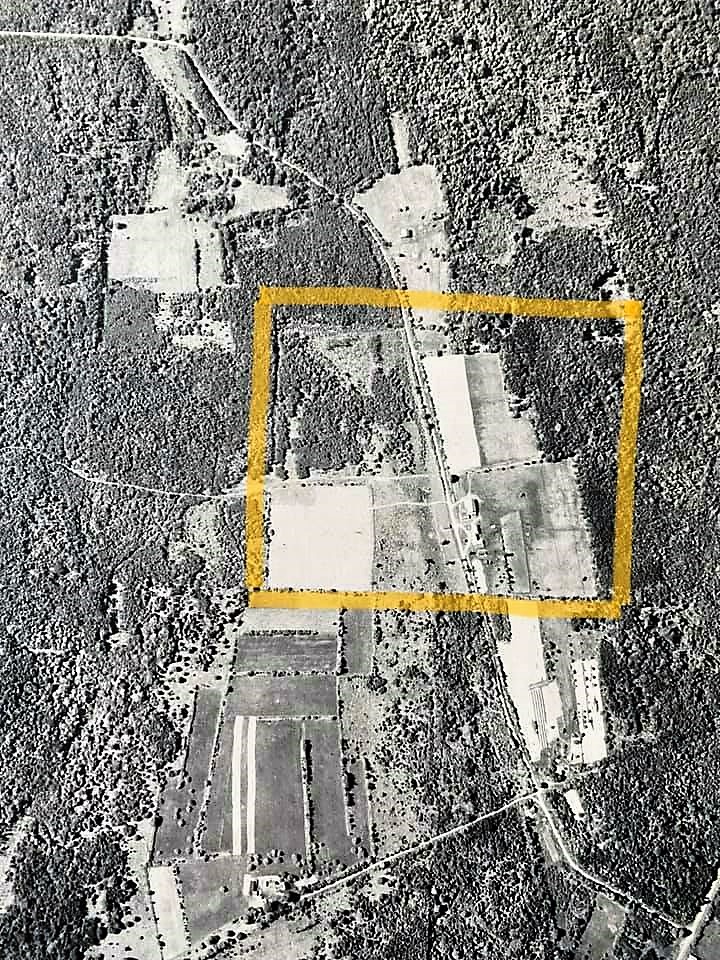
Location of former Town Farm on Huff Hill – 1939
(Photo courtesy of Randy Butler)
*
Two ponds are located in West Hartland along with various streams and brooks.
*
Bowley Pond is a tiny 2 acre pond that drains into Morrill Pond and shares its direct drainage area.
Morrill Pond is a 145 acre pond is situated south of Route 23 in West Hartland on the southwest border of Hartland. A small amount of the pond has its western shoreline is in Canaan but the vast majority is within Hartland. Its mean depth is 16 feet and maximum depth is 48 feet. It has a small inlet from Bowley Pond and a main outlet that drains south to Sibley Pond in Canaan and Pittsfield.
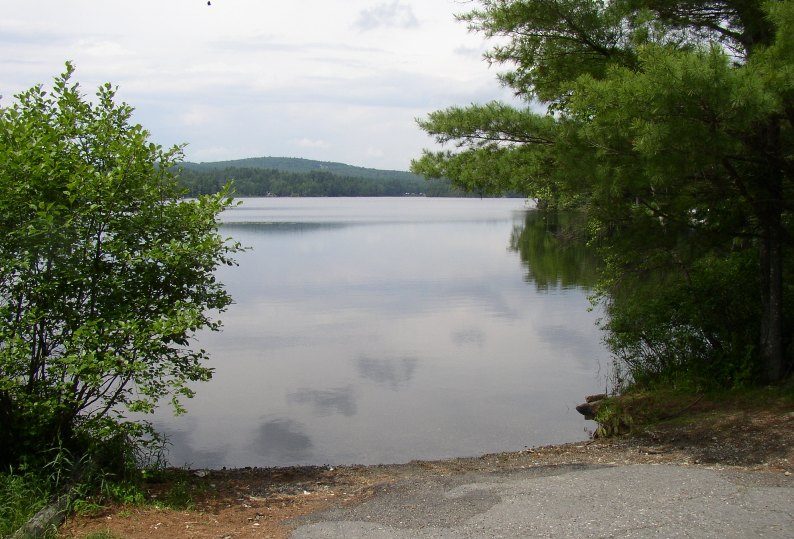
Morrill Pond – West Hartland
*
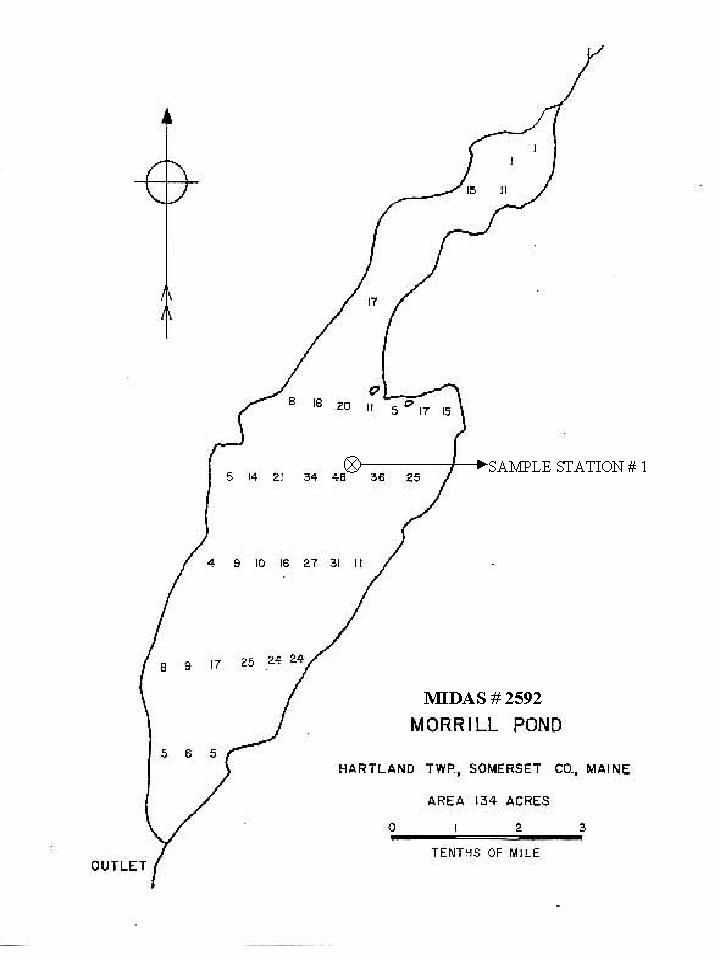
Morrill Pond – West Hartland
*
The Morrill Pond Fish & Game Association was formed in 1951 to serve and protect the interests of Morrill Pond. There were 16 original charter members and within a few years, the association had an enrollment of over 100 members.
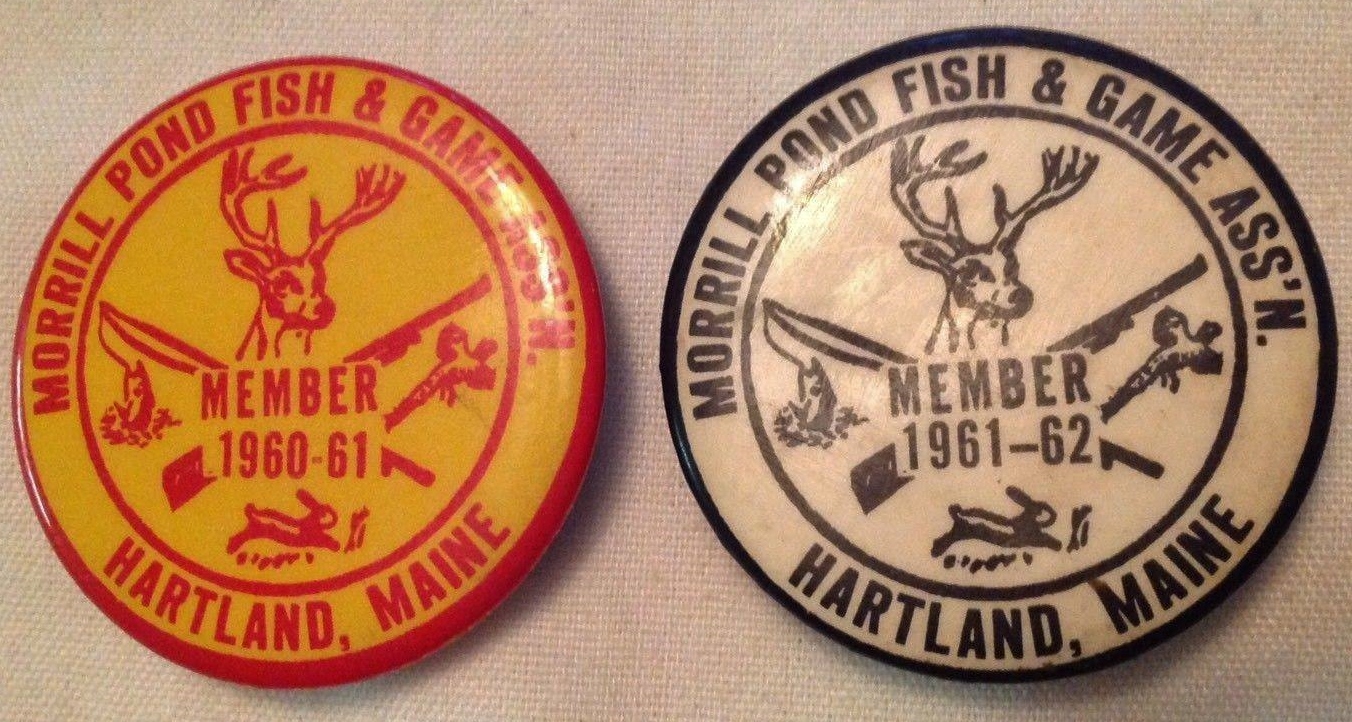
Morrill Pond Fish & Game Association Membership Pins
*
They built their clubhouse in 1955 on land donated to the association by Samuel E. Damon.
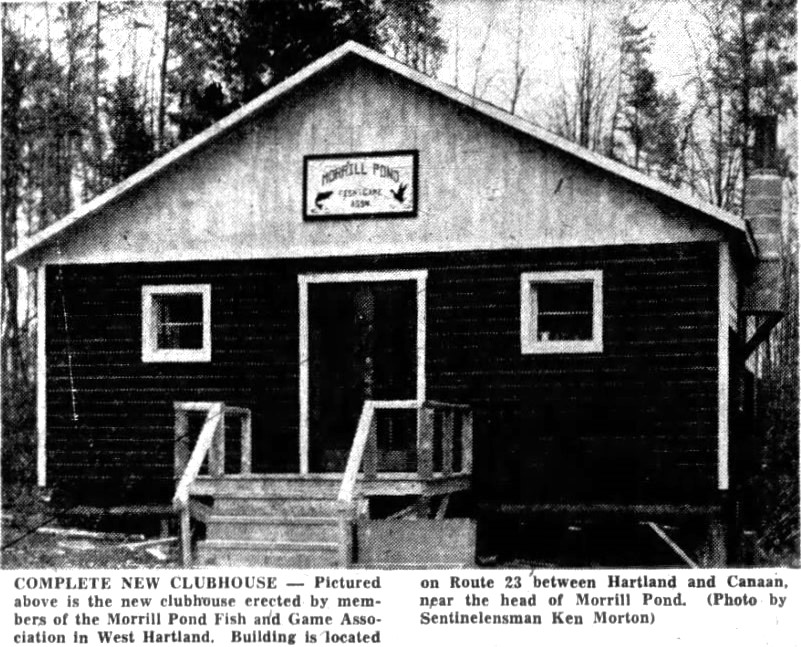
New Morrill Pond Fish & Game Association Clubhouse – November 1, 1955 – Morning Sentinel
*
In 2024, Morrill Pond Fish & Game Association Meeting Minutes since its inception were graciously donated to the Hartland Historical Society.
*
West Hartland continued as a major population center of Hartland and hosted one of the Bi-Annual Town Meetings for a couple more decades until several factors began to change its role including the death of James Fuller, Sr in 1845 and Ambrose Finson in 1857; two of the more politically influential men of the region for decades. Another subtle but decisive move came when James Fuller, Jr left West Hartland in the late 1840s to settle in the part of the Village on Elm Street recently annexed from St Albans in 1846 where he would establish himself as a successful businessman and become heavily involved with town affairs.
With an unlimited source of water power available from the Sebasticook River, several industries in the Village also influenced the inevitable shift of Hartland’s population and political center. The newest and most notable industry was the new Linn Woolen Mill built in 1863. The mill lured in many citizens from the outlying regions of West Hartland and North Hartland seeking alternative means of employment to the grueling task of farming. Numerous new businesses, including several general stores, began after the mill opened adding to the Village’s growth and influence.
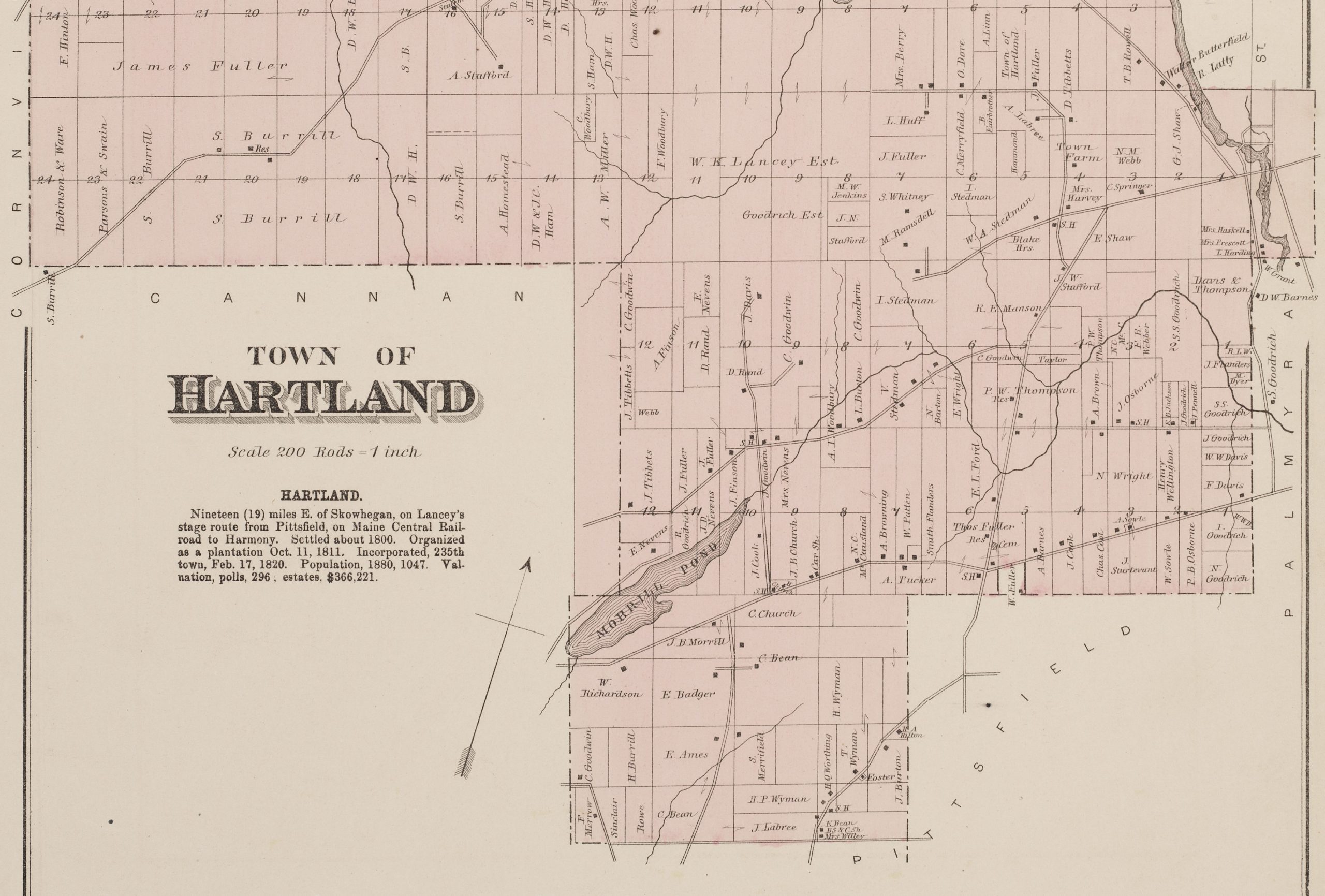
West Hartland – 1883
To see a complete and enlargeable version of this original map, click on the link below:
1883 Map at Fogler Library at UMO
*
Many of the homesteads located in Palmyra in 1883 straddled the West Hartland town line along Pittsfield Avenue.
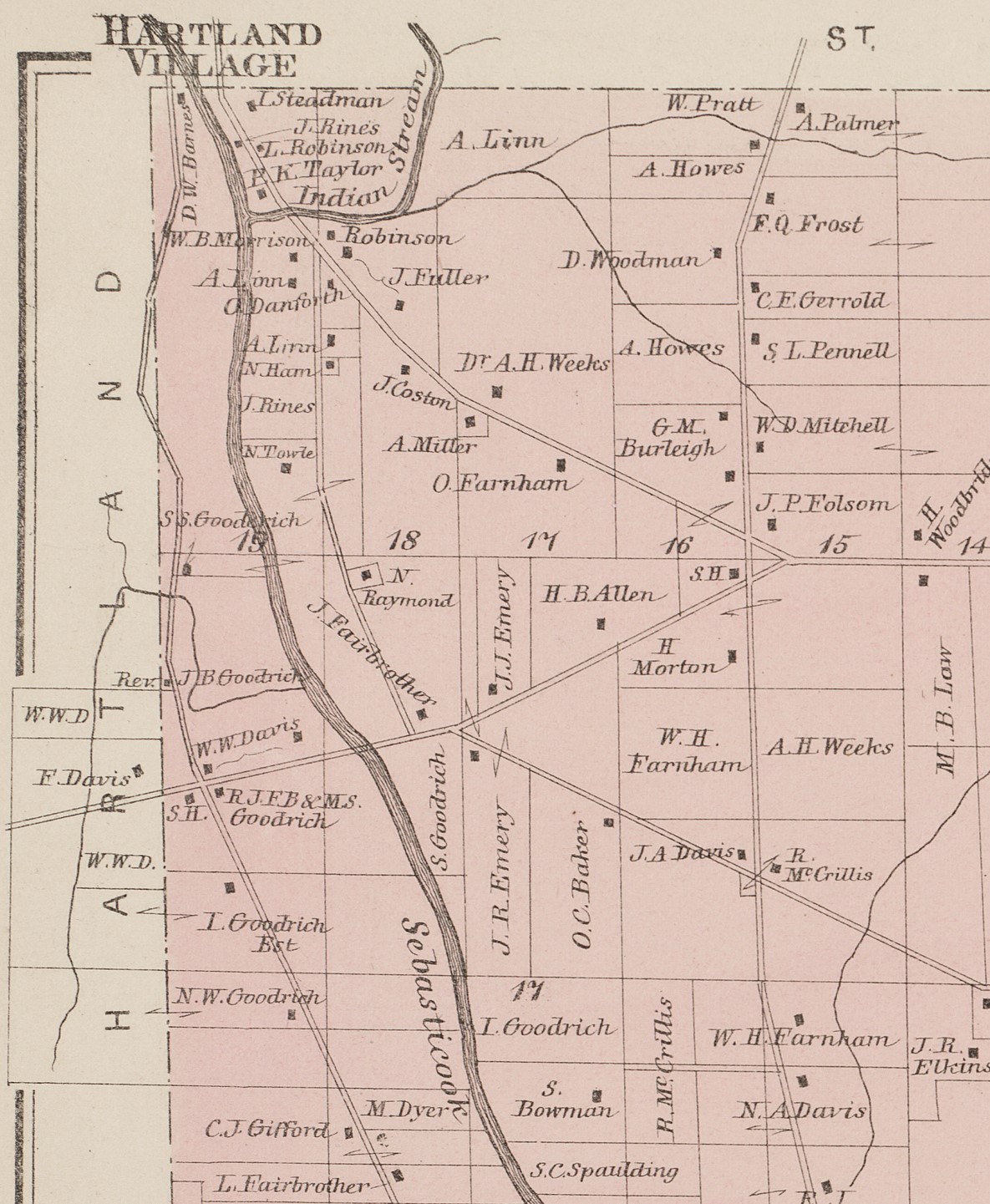
West Hartland-Palmyra Town Line – 1883
*
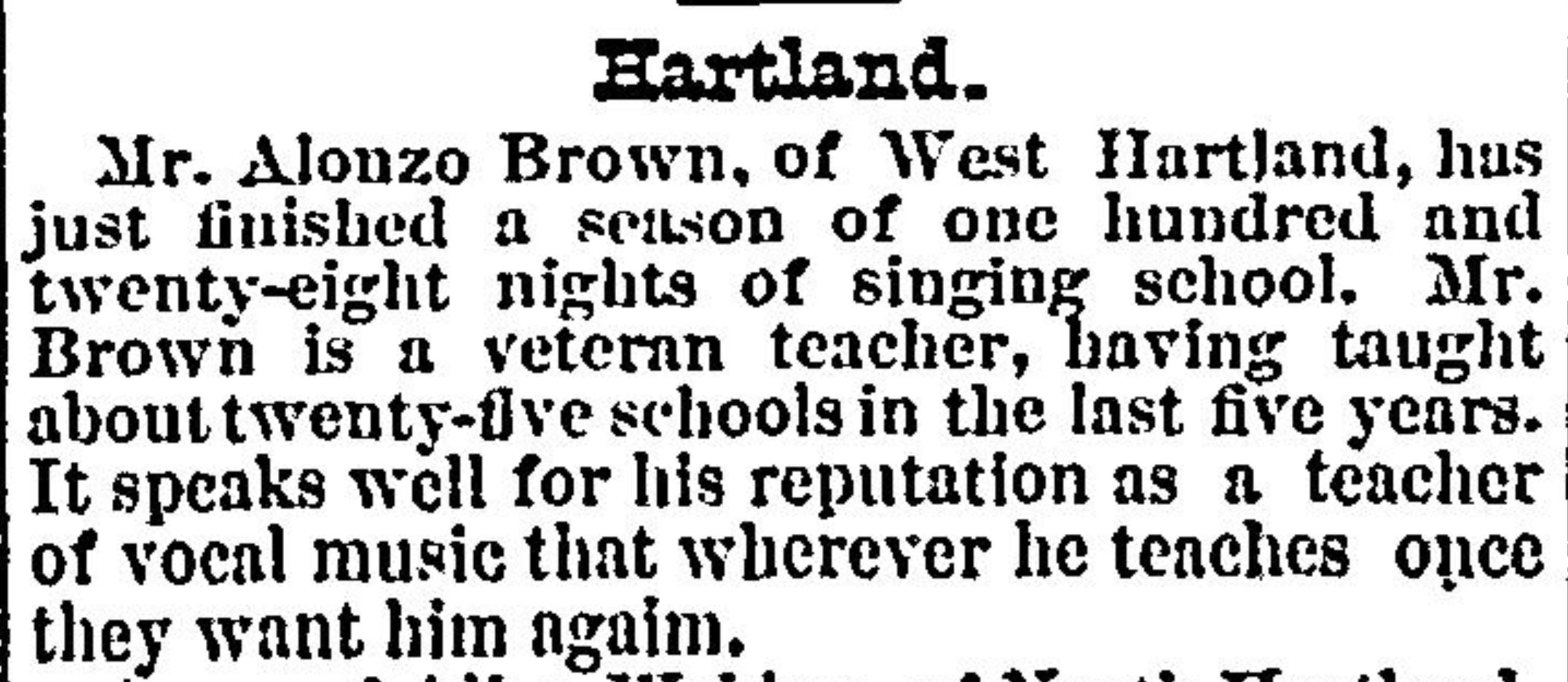
Alonzo Brown Article – 1886
*
The railroad finally came to Hartland when the Sebasticook & Moosehead Railroad officially opened its 8 mile line from Pittsfield in 1886 further adding to the Village’s growth and influence as a future center of town affairs.
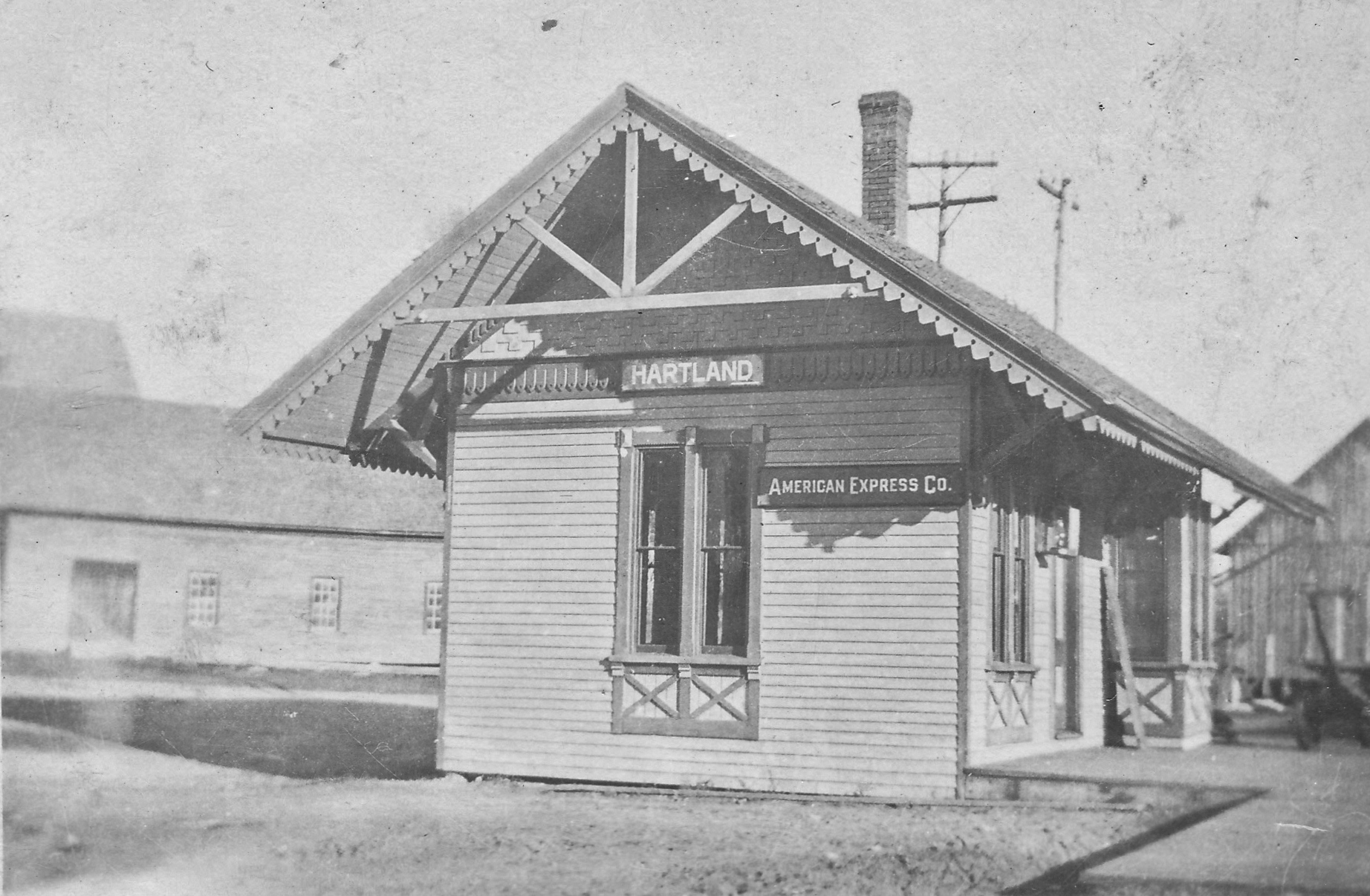
Original Hartland Railroad Depot on Outer Main Street
*
Although the Village’s influence on town affairs was led by many powerful men, including Archibald Linn, Greenville Shaw and James Fuller, Jr, change would not come quickly. The often heated debate over the location of a dedicated Town Hall continued for another 30 years before the Village officially became the center of Hartland town affairs when its citizens finally voted to build a Town Hall on Academy Street in 1892.
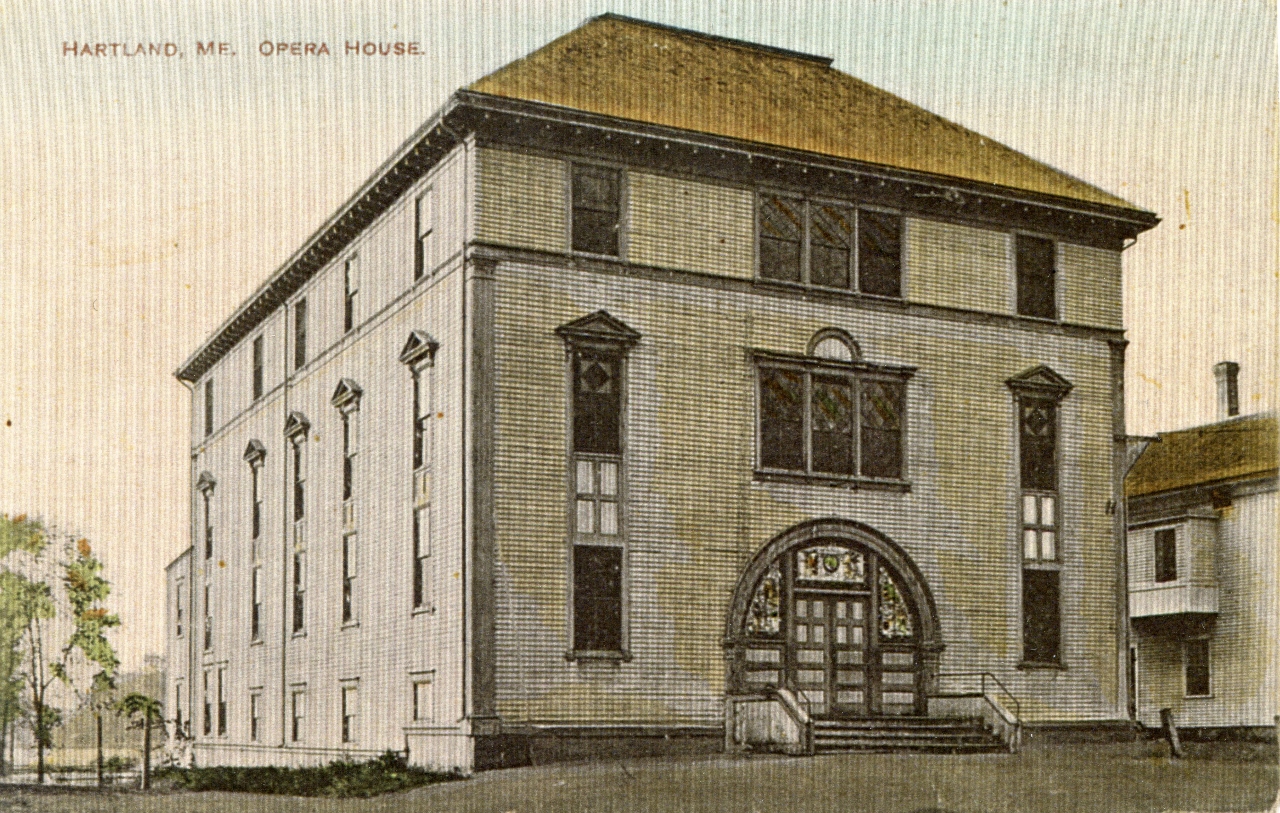
Hartland Town Hall ~ Opera House on Academy Street
*
As noted in a November 4, 1886 article from the Pittsfield Advertiser, “In West Hartland, the old (James) Fuller house has been purchased by Joseph Emery of Palmyra. It has been taken down and will be moved to the village where it will be rebuilt for a store near the depot.”
*
The store built near the depot would later be purchased by Lewis D. Wheeler who operated his store at the location. After exchanging hands a couple more times, the building eventually became the home of the Corinthian Lodge F. & A. M. in 1958 where it remains to this day.
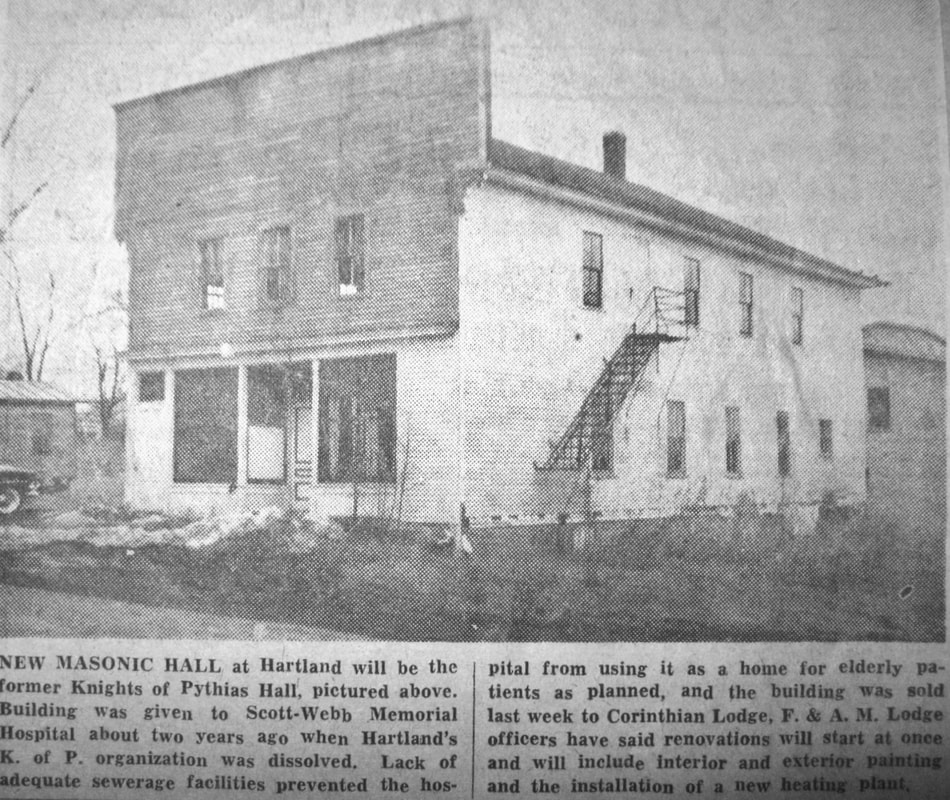
Corinthian Lodge on Outer Main Street – 1958
*
Thomas Fuller (1816-1904), son of James Fuller, Sr & Rebecca Lancey, built his farmhouse on his father’s original lot soon after he married Laura Butterfield (1816-1904) around 1845. They raised their 2 surviving daughters, Ellen and Elizabeth, and remained there until their deaths.
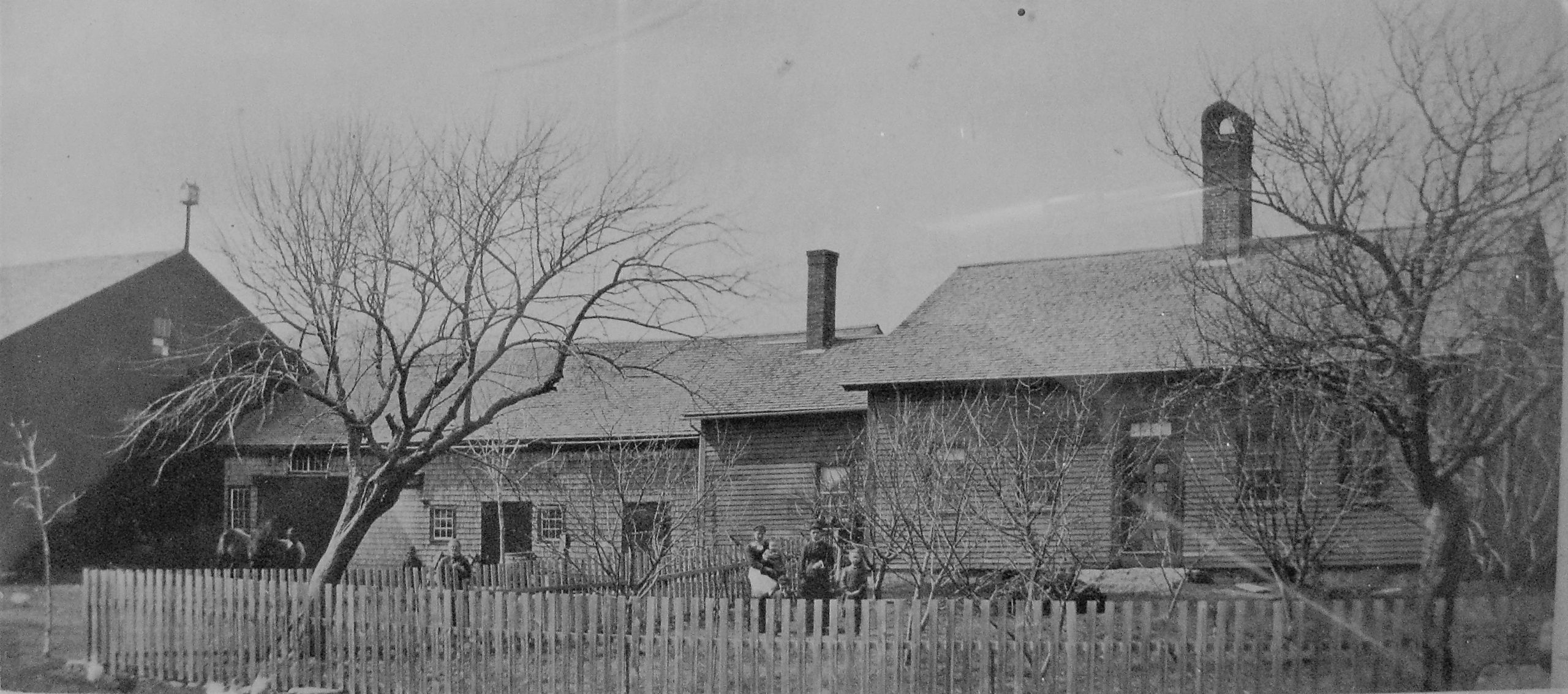
Thomas & Laura Fuller Homestead at Fullers Corner in West Hartland – c1885
*
Thomas & Laura’s oldest daughter, Ellen Maude Fuller, married Harrison Randlett in 1867 and the young couple resided at their West Pittsfield Homestead just over the West Hartland Town Line about a mile from Fullers Corner where they raised their 5 surviving children, Carl Fuller Randlett, Thomas Fuller Randlett, Annie Belle Randlett, Harry Elwin Randlett & Laura Effie Randlett.
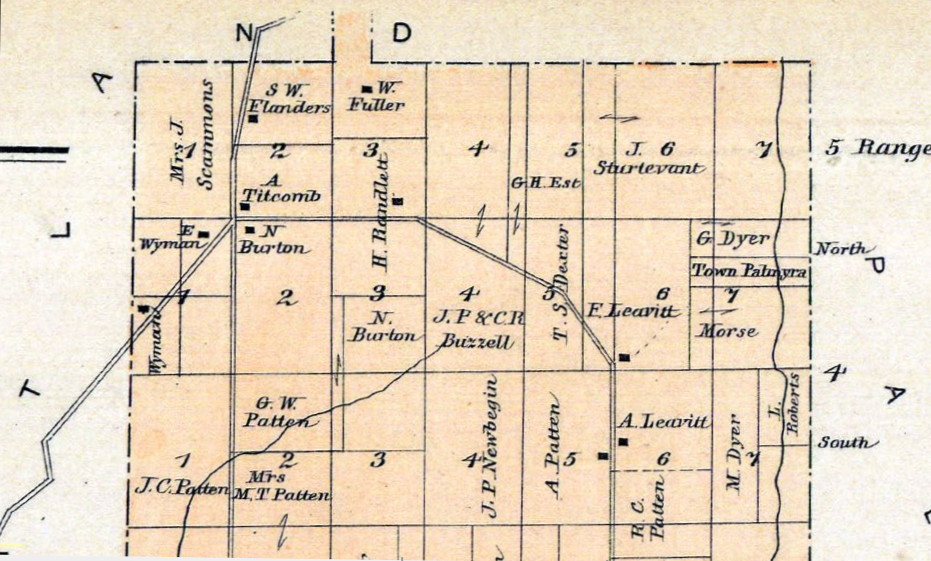
Harrison & Ellen Randlett Homestead in West Pittsfield – 1883
*
Harrison & Ellen Randlett moved in with her parents at the Fullers Corner Homestead around 1895 with their 2 youngest children, Harry & Laura. By this time, the original barn had been replaced with a new structure.
While we are not 100% positive, the people seen in the photo below match up almost perfectly to the 1900 Census which notes those living at the Thomas Fuller Homestead at Fullers Corner in West Hartland and their ages at the time. The younger man standing to the left (Harry Randlett, 21 yrs old in 1900). The older gentleman standing in the center (Thomas Fuller, 82 yrs old) with his hand on an older lady’s shoulder (his wife, Laura Fuller, 84 yrs old). To the right of Laura is a middle aged woman (Ellen Randlett, 52 yrs old) and to the far right is a middle aged man, (Harrison Randlett, 56 yrs old) The only person missing from this photo noted living there when the 1900 Census was taken on June 21st is Harrison & Ellen’s youngest child, (Laura Randlett, 18 yrs old) who could possibly be the photographer or may have moved away by this time.
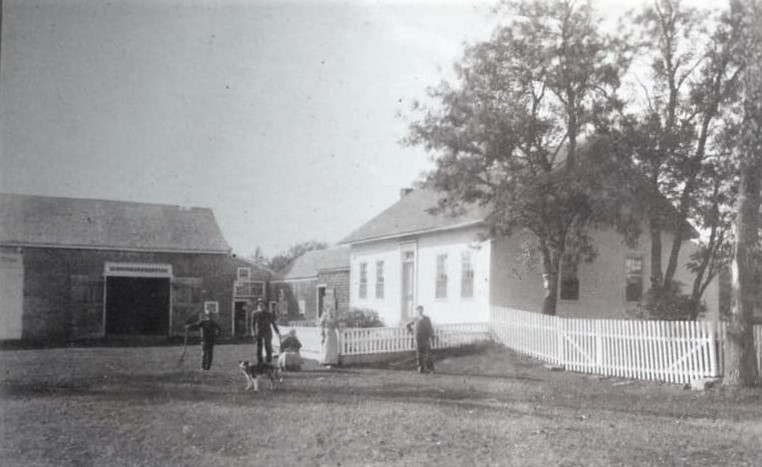
Thomas & Laura Fuller Homestead at Fullers Corner in West Hartland – c1900
(Photo courtesy of Deborah Tapley)
*
Surviving children of Harrison & Ellen (Fuller) Randlett at their parents’ West Hartland home in the early 1900s.
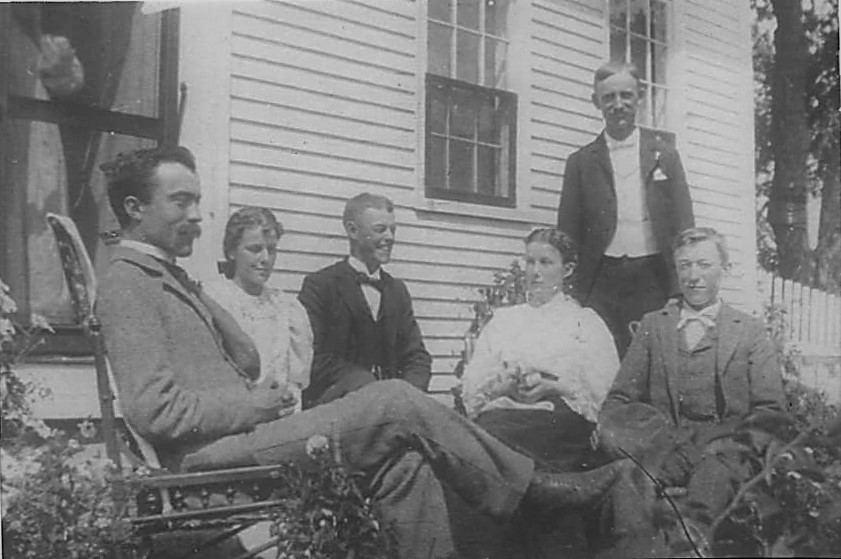
(L-R): Carl Randlett, Laura Randlett, Thomas Randlett, Annie (Randlett) Morse, her husband Fred Morse & Harry Randlett
(Photo courtesy of Deborah Tapley)
*
Following the deaths of both Thomas & Laura Fuller within a month of each other in 1904, Harrison & Ellen inherited the homestead then sold it in 1907 to William Small. It was sold again (twice) in 1918 before being purchased in May of 1919 by Emerson Randolph Pelkie and his wife Iva Pearl Dickinson.
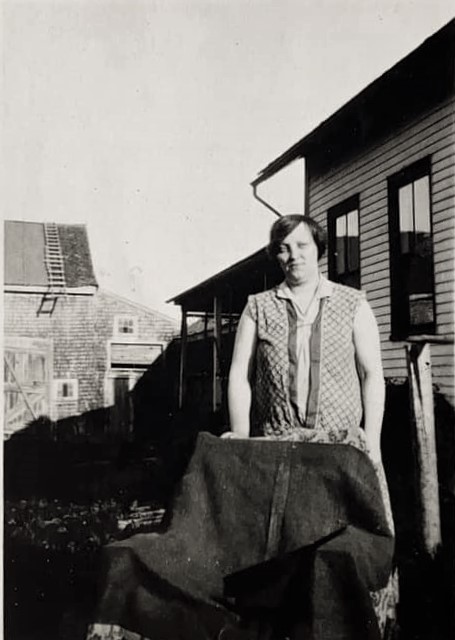

Iva (Dickerson) Pelkie & son Kenneth Leroy Pelkie at the former Thomas Fuller Homestead – 1930
(Photo courtesy of Randy Butler)
*
Following Emerson’s death in December of 1940 after a lengthy illness, the Pelkie Homestead was taken over by their son Donald J. Pelkie and his newly wedded wife Glenice A. Perkins. Donald had left school at 16 years old in 1936 when his father had first become ill to tend to the farm and help pay the mortgage according to his family.
*
Glenice & Donald Pelkie with their surviving children at their homestead at Fullers Corner in West Hartland.
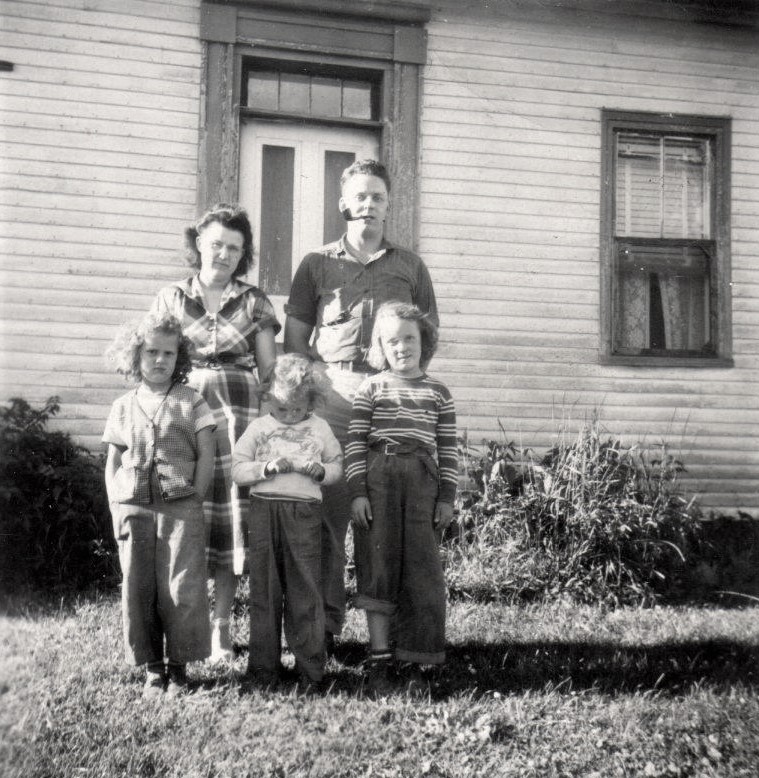
Glenice & Donald Pelkie with Jackie, Donna & Gloria – 1950
(Photo courtesy of Randy Butler)
*
Donald Pelkie and his family were still living at the homestead when it burnt in 1951. The Pelkie Homestead and the former Prince Thompson Homestead, located just above Pelkie’s home which had burnt down just the week before, were two of the oldest remaining farmhouses in Hartland at the time. A new house would soon be built on the lot and descendants of Emerson Pelkie still live on the same lot today bringing the total to 6 generations of Pelkie Family living on the same land for over 100 years.

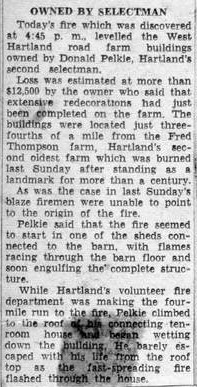
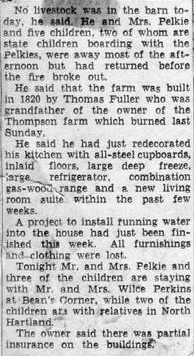
Pelkie Homestead Fire Article – July 13, 1951
*
Charles Springer (1842-1914) was a Civil War Veteran with the 11th Maine Infantry, Company E and worked most of his life at the Linn Woolen Mill. He and his wife Christiana Nevens lived on the Canaan Road just before Huff Hill. Their only child Harry Springer took over the family homestead before selling it to Harold Emery and his wife Leona Cyr. The farm was struck by lightening on August 10, 1955 and burnt to the ground. Joe Lewis and his wife Christine Parent later built a new house nearer to the road in front of the former farmhouse location.
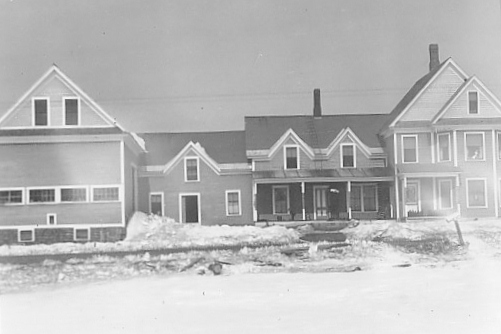
Former Charles Springer & Harold Emery Homestead
*
An aerial photo from the 1940s looking westerly showing the Charles Watts Salisbury Homestead (1st from the right).
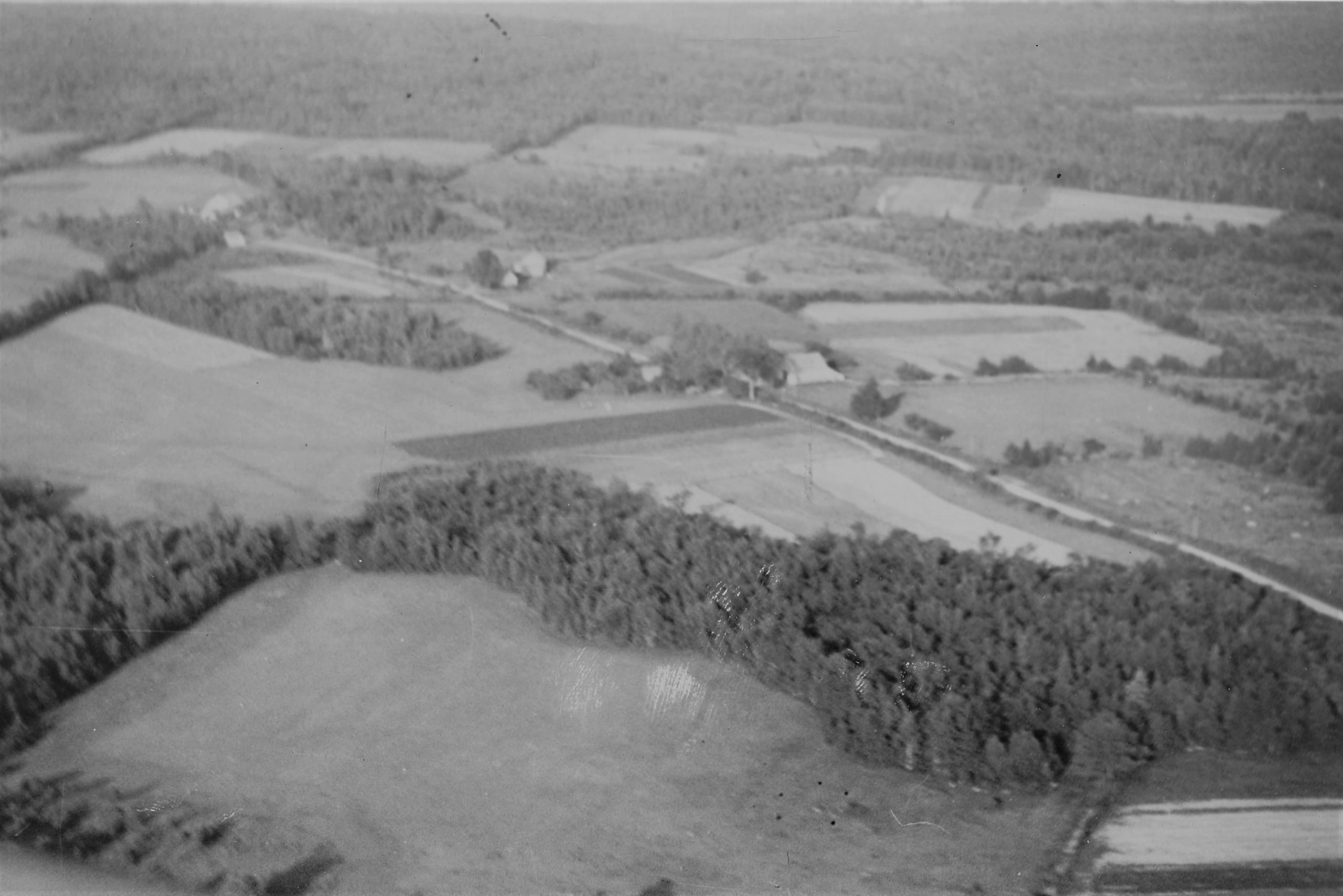
Beans Corner Road – West Hartland – 1940s
(Courtesy of Virginia Salisbury Tucker)
*
Students at Fullers Corner School in West Hartland in 1940 just before the school closed in 1942.
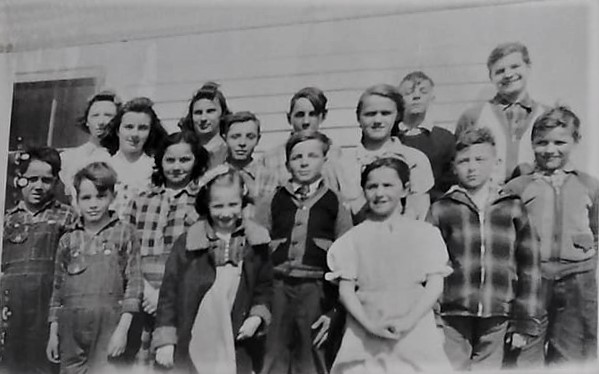
Fullers Corner School – West Hartland – 1940
(Courtesy of Wendell Bubar)
1st Row: Raymond Robinson | Edith Southard | Gladys Robinson
2nd Row: Gerald Robinson | Iola Robinson | Olin Salisbury Jr | Norman Levasseur
3rd Row: Virginia Salisbury | Robert Mason | Marjorie McDougal | Luther McDougal
4th Row: Alta Hillman | Joyce Pelkie | Floyd Robinson | Kenneth Pelkie | Ernest McDougal Jr
A digital scan of the 1943 Map is forthcoming and will replace this rough photographed version.
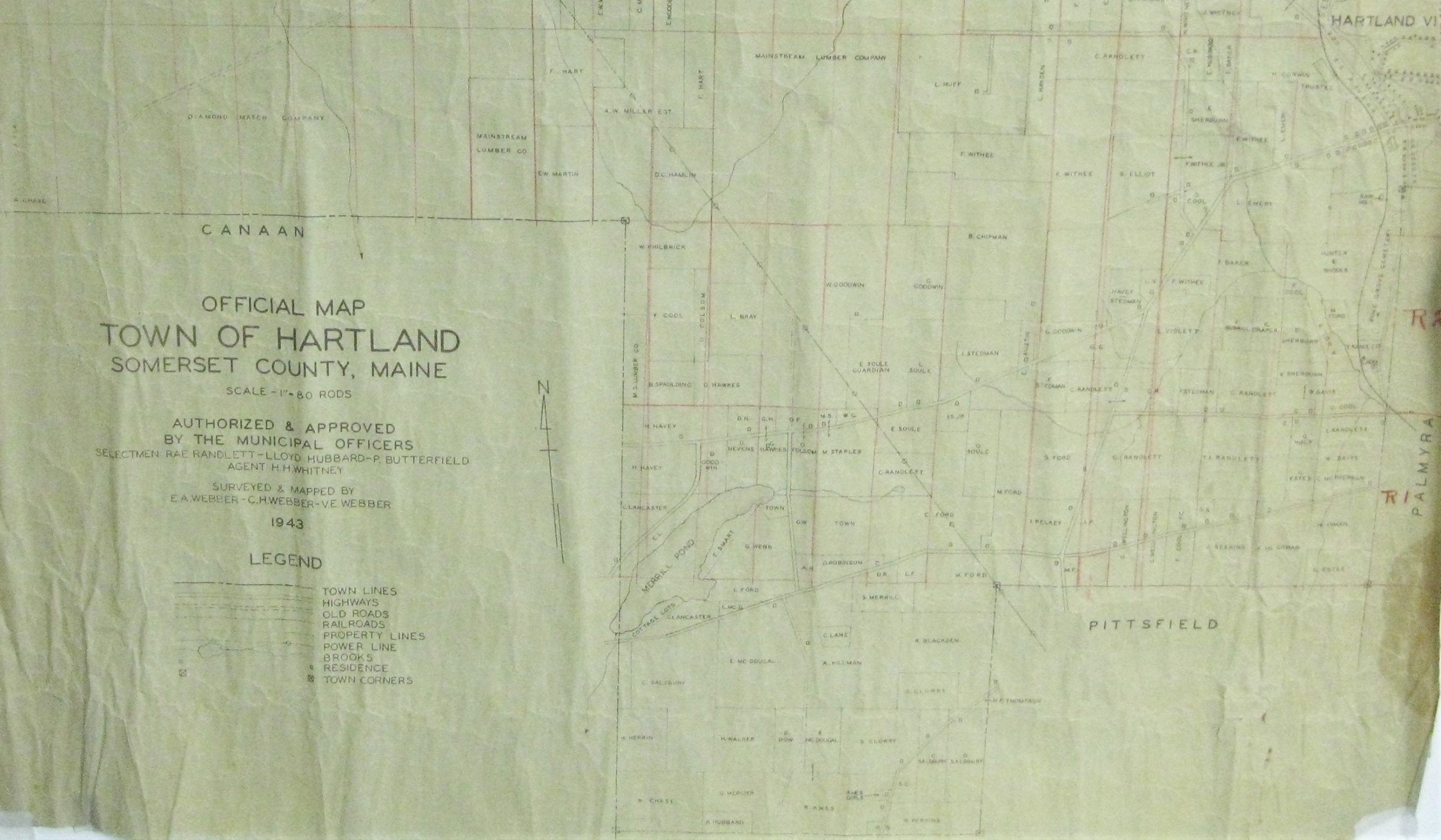
West Hartland – 1943